An Overview of HVDC Technology
Abstract
1. Introduction
2. HVDC Technology Overview/Background
2.1. Advantages of HVDC
- Asynchronous connection (can connect two AC systems of different frequency).
- Overcoming technical limitations. HVDC can supply via a long cable system when an AC system cannot. This is due to the high cable capacitance causing a large capacitive current (reactive power flow) that leaves reduced current capacity for the transmission of real power when AC transmission is used.
- No increase in short-circuit capacity (there is no need to upgrade protection equipment due to the link).
- Controllable real power transfer (independent of Z, V & f). The ability supply power to any pre-specified criteria (the controller can be set to a variety of functions).
- Higher power transfer for a given conductor.
- No stability distance limitation.
- The lack of reactive voltage drop means better voltage regulation for both heavy loading and light loading (no Ferranti effect).
- Narrower right-of-way (better land use).
- Higher power transfer for a given conductor.
- Advanced control features can improve the stability of the AC systems and act as a fast generation reserve.
2.2. Power Electronic Switches
2.3. Current Source Converters
2.4. Voltage Source Converters
2.5. Topologies
3. Comparison of Current Source and Voltage Source Converters
3.1. Introduction
3.2. Current Source Converters
3.3. Voltage Source Converters
- Neutral-point clamped circuit (also called a diode-clamped circuit)
- Flying Capacitor
- Cascaded H-bridge
- Modular Multi-level Converter (MMC)
- Circulating currents are inherent in the MMC topology.
- These currents cause variations in the capacitor voltages and increase converter losses.
- Capacitor voltages variations increase with increase in load current and circulating currents.
4. Historical Development
5. Innovations in HVDC
5.1. Capacitor Commutated Converter
- Reduced reactive power demand hence reducing the amount of shunt compensation
- Reduced area requirements
- Simplified AC switchyard
- Increased immunity to commutation failures
- Increased stability at low SCR
- Smaller overvoltages at load rejection
- No AC side zero sequence currents
- Improved control properties
- Reduces shunt bank switching and transformer OLTC operations (reduces operation and maintenance costs)
5.2. Continuously Tuned AC Filter
5.3. Active DC Side Filters
5.4. Reinjection Concept
5.5. DC Faults
6. Discussion
6.1. VSC HVDC Systems
6.2. CSC-Based HVDC Systems
- Load rejection overvoltages
- Temporary overvoltage after recovering from an AC system fault
- Voltage change on reactive switching
- AC network frequency and stabilisation/modulation control
- Possible subsynchronous torsional interactions with nearby turbine-generators.
6.3. Hybrid HVDC Systems
7. Conclusions
Author Contributions
Funding
Conflicts of Interest
Correction Statement
References
- CIGRE WG B6.31. Medium Voltage Direct Current (MVDC) Feasibility Study. Technical Brochure 793. 2020. Available online: https://e-cigre.org/ (accessed on 5 March 2020).
- CIGRE WG B4.55. HVDC Connection of offshore Wind Power Plants. Technical Brochure 619. May 2015. Available online: https://e-cigre.org/ (accessed on 13 July 2015).
- Ryndzionek, R.; Sienkiewicz, L. Evolution of the HVDC Link Connecting Offshore Wind Farms to Onshore Power Systems. Energies 2020, 13, 1914. [Google Scholar] [CrossRef]
- Korompili, A.; Wu, Q.; Zhao, H. Review of VSC HVDC connection for offshore wind power integration. Renew. Sustain. Energy Rev. 2016, 59, 1405–1414. [Google Scholar] [CrossRef]
- Jiang-Häfner, Y.; Lundberg, P. VSC HVDC Transmission Supporting Variable Electricity Generation, CIGRE Session, Paris, 2016, Paper C5-204. Available online: https://e-cigre.org/ (accessed on 17 April 2020).
- Gupta, K.K.; Bhatnagar, P. Multilevel Inverters: Conventional and Emerging Topologies and Their Control; Academic Press: London, UK, 2018. [Google Scholar]
- Mohan, N.; Underland, T.M.; Robbins, W.P. Power Electronics: Converters, Applications, and Design, 3rd ed.; John Wiley & Sons: New York, NY, USA, 2003. [Google Scholar]
- Rashid, M.H. (Ed.) Power Electronics Handbook, 3rd ed.; Butterworth-Heinemann: Burlington, MA, USA, 2011. [Google Scholar]
- Holmes, D.G.; Lipo, T.A. Pulse Width Modulation for Power Converter: Principles and Practice; IEEE Press: Piscataway, NJ, USA, 2003. [Google Scholar]
- Wu, B. High-Power Converters and AC Drives; IEEE Press: Piscataway, NJ, USA, 2006. [Google Scholar]
- Shepherd, W.; Zhang, L. Power Converter Circuits; Marcel Dekker: New York, NY, USA, 2004. [Google Scholar]
- Sharkh, S.M.; Abusara, M.A.; Hussain, B. Power Electronic Converters for Microgrids; John Wiley & Sons: Singapore, 2014. [Google Scholar]
- General Electric Canada Inc. Power Converter Handbook: Theory, Design, Application; UYK Technologies: Bailieboro, ON, Canada, 2005. [Google Scholar]
- Adamson, C.; Hingorani, N.G. High Voltage Direct Current Power Transmission; Garraway: London, UK, 1960. [Google Scholar]
- Kimbark, E.K. Direct Current Transmission: Volume 1; John Wiley & Sons: New York, NY, USA, 1971. [Google Scholar]
- Uhlmann, E. Power Transmission by Direct Current; Springer: Berlin/Heidelberg, Germany, 1975. [Google Scholar]
- Arrillaga, J. High Voltage Direct Current Transmission, 2nd ed.; IEEE: London, UK, 1998. [Google Scholar]
- Padiyar, K.R. HVDC Power Transmission Systems: Technology and System Interactions; John Wiley & Sons: New Delhi, India, 1990. [Google Scholar]
- Yazdani, A.; Iravani, R. Voltage-Sourced Converters in Power Systems: Modeling, Control and Applications; John Wiley & Sons: Hoboken, NJ, USA, 2010. [Google Scholar]
- Jovcic, D.; Ahmed, K. High Voltage Direct Current Transmission: Converters, Systems and DC Grids; John Wiley & Sons: Chichester, UK, 2015. [Google Scholar]
- Kim, C.-K.; Sood, V.K.; Jang, G.-S.; Lim, S.-J.; Lee, S.-J. HVDC Transmission: Power Conversion Applications in Power Systems; John Wiley & Sons: Singapore, 2009. [Google Scholar]
- Arrillaga, J.; Liu, Y.H.; Watson, N.R. Flexible Power Transmission: The HVDC; John Wiley & Sons: Chichester, UK, 2007. [Google Scholar]
- Arrillaga, J.; Liu, Y.H.; Watson, N.R.; Murray, N.J. Self-Commutating Converters for High Power Applications; John Wiley & Sons: Chichester, UK, 2009. [Google Scholar]
- Chaudhuri, N.R.; Chaudhuri, B.; Majumder, R.; Yazdani, A. Multi-terminal Direct-Current Grids: Modeling, Analysis, and Control; IEEE Press: Piscataway, NJ, USA, 2014. [Google Scholar]
- Sharifabadi, K.; Harnefors, L.; Nee, H.-P. Design, Control, and Application of Modular Multilevel Converters for HVDC Transmission Systems; John Wiley & Sons: Hoboken, NJ, USA, 2016. [Google Scholar]
- Acha, E.; Roncero-Sanchez, P.; de la Villa, A.; Castro, L.M.; Kazemtabrizi, B. VSC-FACTS-HVDC: Analysis, Modelling and Simulation in Power Grids; John Wiley & Sons: Chichester, UK, 2019. [Google Scholar]
- ABB. ABB Review: Special Report 60 Years of HVDC. July 2014. Available online: https://new.abb.com/about/technology/abb-review (accessed on 15 July 2020).
- Kharade, J.M.; Savagave, N.G. A Review of HVDC Converter Topologies. Int. J. Innov. Res. Sci. Eng. Technol. 2017, 6, 1822–1830. [Google Scholar] [CrossRef]
- Wang, F.; Bertling, L.; Le, T.; Mannikoff, A.; Bergman, A. An Overview Introduction of VSC-HVDC: State-of-art and Potential Applications in Electric Power Systems. In Proceedings of the Cigrè International Symposium, Bologna, Italy, 13–15 September 2011. [Google Scholar]
- Abbas, A.M.; Lehn, P.W. PWM based VSC-HVDC systems—A review. In Proceedings of the 2009 IEEE Power and Energy Society General Meeting, Calgary, AB, Canada, 26–30 July 2009. [Google Scholar] [CrossRef]
- Buigues, G.; Valverde, V.; Etxegarai, A.; Eguia, P.; Torres, E. Present and future multiterminal HVDC systems: Current status and forthcoming. In Proceedings of the International conference on Renewable Energies and Power Quality, Malaga, Spain, 4–6 April 2017; pp. 83–88. [Google Scholar] [CrossRef]
- Barnes, M.; Beddard, A. Voltage Source Converter HVDC Links—The state of the Art and Issues Going Forward. Energy Procedia 2012, 24, 108–122. [Google Scholar] [CrossRef]
- Rodríguez, J.; Lai, J.-S.; Peng, F.Z. Multilevel Inverters: A Survey of Topologies, Controls, and Applications. IEEE Trans. Ind. Electron. 2020, 49, 724–738. [Google Scholar] [CrossRef]
- Bahrman, M. HVDC Technology: Line Commutated Converters. Presentation at IEEE PES T&D, Chicago. 15 April 2014. Available online: https://www.ieee-pes.org/presentations/td2014/td2014p-000668.pdf (accessed on 4 June 2020).
- Maza-Ortega, J.M.; Acha, E.; Garcia, S.; Gomez-Exposito, A. Overview of power electronics technology and applications in power generation transmission and distribution. J. Mod. Power Sys. Clean Energy 2017, 5, 499–514. [Google Scholar] [CrossRef]
- Rudervall, R.; Charpentier, J.P.; Sharma, R. High Voltage Direct Current (HVDC) Transmission Systems Technology Review Paper, Energy Week 2000, Washington, DC, USA, 7–8 March 2000. Available online: http://large.stanford.edu/courses/2010/ph240/hamerly1/docs/energyweek00.pdf (accessed on 14 April 2020).
- CIGRE Working Group B4.46. Voltage Source Converter (VSC) HVDC for Power Transmission—Economic Aspects and Comparison with Other AC and DC Technologies, Technical Brochure 492. April 2012. Available online: https://e-cigre.org/ (accessed on 30 May 2020).
- Siemens. High Voltage Direct Current Transmission—Proven Technology for Power Exchange, Answers for Energy, Siemens AG, Erlangen, Germany. 2011. Available online: www.siemens.com/energy/hvdc (accessed on 15 June 2017).
- CIGRE B14.17. Semiconductor Power Devices for Use in HVDC and FACTS Controllers, Technical Brochure 112. 1997. Available online: https://e-cigre.org/ (accessed on 30 May 2020).
- Jacobson, B. Developments in Multiterminal HVDC, IEEE EPEC 2911, Winnipeg, Canada. 2011. Available online: http://www.ieee.ca/epec11/admin/04-0800-hvdc_plenary_jacobson.pdf (accessed on 14 April 2020).
- Arrillaga, J.; Camacho, J.R.; MacDonald, S.J.; Arnold, C.P. Operating characteristics of unit and group connected generator-HVDC converter schemes. IEE Proc. C Gener. Transm. Distrib. 1993, 140, 503–508. [Google Scholar] [CrossRef]
- Kuruganty, S. Comparison of reliability performance of group connected and conventional HVdc transmission systems. IEEE Trans. Power Deliv. 1995, 10, 1889–1895. [Google Scholar] [CrossRef]
- CIGRE WG B11/14.09. Guide for Preliminary Design and Specification of Hydro Stations with HVDC Unit Connected Generators, Technical Brochure 116. 1997. Available online: https://e-cigre.org/ (accessed on 2 September 2015).
- CIGRE WG 14.03. AC Harmonic Filters and Reactive Compensation for HVDC with Particular Reference to Non-Characteristic Harmonics, Technical Brochure 65. June 1990. Available online: https://e-cigre.org/ (accessed on 2 September 2015).
- CIGRE WG 14.30. Guide to the Specification and Design Evaluation of AC Filters for HVDC Systems, Technical Brochure 139. 1999. Available online: https://e-cigre.org/ (accessed on 27 February 2012).
- CIGRE WG 14.03.02. DC Side Harmonics and Filtering in HVDC Transmission Systems, Technical Brochure 92. 1995. Available online: https://e-cigre.org/ (accessed on 27 February 2012).
- CIGRE WG B4.47. Special Aspects of AC Filter Design for HVDC Systems, Technical Brochure 553. 2013. Available online: https://e-cigre.org/ (accessed on 10 June 2020).
- CIGRE Working group B4.37. VSC Transmission, Technical Brochure 269. April 2005. Available online: https://e-cigre.org/ (accessed on 30 May 2020).
- Dodds, S.; Railing, B.; Akman, K.; Jacobson, B.; Worzyk, T.; Nilsson, B. HVDC VSC (HVDC light) Transmission—Operating Experiences, Paper B4-203, CIGRE 2010. Available online: https://e-cigre.org/ (accessed on 4 May 2020).
- Davies, M.; Dommaschk, M.; Dorn, J.; Lang, J.; Retzmann, D.; Soerangr, D. HVDC Plus—Basics and Principle of Operation, Siemens Ag, Erlangen, Germany. 2009. Available online: www.siemens.com/energy (accessed on 2 February 2017).
- Jacobson, B.; Jiang-Häfner, Y.; Rey, P.; Asplund, G.; Jeroense, M.; Gustafsson, A.; Bergkvist, M. HVDC with Voltage Source Converters and Extruded Cables For Up To ±300 kV And 1000 MW, CIGRE Paris 2006, Paper B4-105. Available online: https://e-cigre.org/ (accessed on 5 May 2020).
- Mattsson, I.; Ericsson, A.; Railing, B.D.; Miller, J.J.; Williams, B.; Moreau, G.; Clarke, C.D. MurrayLink, The Longest Underground HVDC Cable In The World, Paper B4-2013, CIGRE 2004. Available online: https://e-cigre.org/ (accessed on 6 April 2020).
- Railing, B.D.; Miller, J.J.; Steckley, P.; Moreau, G.; Bard, P.; Ronström, L.; Lindberg, J. Cross Sound Cable Project Second Generation VSC Technology for HVDC, CIGRE Session, Paris, 2004, Paper B4-102. Available online: https://e-cigre.org/ (accessed on 7 April 2020).
- CIGRE WG 14.05. Interaction between HVDC Convertors and Nearby Synchronous Machines. Final Report. Technical Brochure No. 119. 1997. Available online: https://e-cigre.org/ (accessed on 30 May 2020).
- CIGRE WG B4.67. AC Side Harmonics and Appropriate Harmonic Limits for VSC HVDC, Technical Brochure 754. 2019. Available online: https://e-cigre.org/ (accessed on 27 February 2019).
- CIGRE WG B4.66. Implications for Harmonics and Filtering of the Installation of HVDC Converter Stations in Close Proximity, Technical Brochure 798. 2020. Available online: https://e-cigre.org/ (accessed on 30 May 2020).
- Rodriguez, J.; Bernet, S.; Steimer, P.K.; Lizama, I.E. A survey of neutral-point-clamped Inverters. IEEE Trans. Ind. Electron. 2010, 57, 2219–2230. [Google Scholar] [CrossRef]
- Barbosal, P.; Steimer, P.; Steinke, J.; Winkehnkemperl, M.; Celanovic, N. Active-Neutral-Point-Clamped (ANPC) Multilevel Converter Technology. In Proceedings of the European Conference on Power Electronics and Applications (EPE 2005), Dresden, Germany, 11–14 September 2005. [Google Scholar] [CrossRef]
- Dargahi, V.; Corzine, K.A.; Enslin, J.H.; Rodríguez, J.; Blaabjerg, F. Improved Active-Neutral-Point-Clamped (I-ANPC) Multilevel Converter: Fundamental Circuit Topology, Innovative Modulation Technique, and Experimental Validation. In Proceedings of the 2018 IEEE Power and Energy Conference at Illinois (PECI), Champaign, IL, USA, 22–23 February 2018; pp. 1–8. [Google Scholar] [CrossRef]
- Lesnicar, A.; Marquardt, R. An innovative modular multilevel converter topology suitable for a wide power range. In Proceedings of the 2003 IEEE Bologna PowerTech Conference, Bologna, Italy, 23–26 June 2003. [Google Scholar] [CrossRef]
- Marquardt, R.; Wang, Y. Tutorial: Modular Multilevel Converter- Fundamentals and Applications, University of Bundeswehr Munich, Germany. Available online: https://studylib.net/doc/18050987/tutorial--modular-multilevel-converter (accessed on 3 May 2017).
- Dorn, J.; Huang, H.; Retzmann, D. A new Multilevel Voltage-Sourced Converter Topology for HVDC Applications, CIGRE Session, Paris, 2008, Paper B4-304. Available online: https://e-cigre.org/ (accessed on 17 April 2020).
- Nami, A.; Liang, J.; Dijkhuizen, F.; Demetriades, G.D. Modular Multilevel Converters for HVDC Applications: Review on Converter Cells and Functionalities. IEEE Trans. Power Electron. 2015, 30, 18–36. [Google Scholar] [CrossRef]
- Axelsson, U.; Holm, A.; Liljegren, C.; Aberg, M.; Eriksson, K.; Tollerz, O. The Gotland HVDC Light Project -Experiences from Trial and Commercial Operation. In Proceedings of the 16th International Conference and Exhibition on Electricity Distribution, Amsterdam, The Netherlands, 18–21 June 2001. [Google Scholar]
- Railing, B.D.; Miller, J.J.; Moreau, G.; Wasborg, J.; Jiang-Häfner, Y.; Stanley, D. The Directlink VSC-Based HVDC Project and Its Commissioning, CIGRE Session, Paris, 2002, Paper 14-0198. Available online: https://e-cigre.org/ (accessed on 6 April 2020).
- Westerweller, T.; Orini, A.; Parquet, D. Trans Bay Cable—World’s First HVDC System Using Multilevel Voltage-Sourced Converter, CIGRE Session, Paris, 2010, Paper B4-101. Available online: https://e-cigre.org/ (accessed on 17 April 2020).
- Jacobson, B.; Karlsson, P.; Asplund, G.; Harnefors, L.; Jonsson, T. VSC-HVDC Transmission with Cascaded Two-Level Converters, CIGRE Session, Paris, 2010, Paper B4-110. Available online: https://e-cigre.org/ (accessed on 17 April 2020).
- Tang, G.; He, Z.; Pang, H.; Huang, X.; Zhang, X.-P. Basic Topology and Key Devices of the Five-Terminal DC Grid. CSEE J. Power Energy Syst. 2015, 1, 22–35. [Google Scholar] [CrossRef]
- Wikipedia. Available online: https://en.wikipedia.org/wiki/List_of_HVDC_projects (accessed on 8 April 2020).
- Gole, A.M.; Meisingset, M. Capacitor commutated converters for long-cable HVDC transmission. Power Eng. J. 2002, 16, 129–134. [Google Scholar] [CrossRef]
- Meisingset, M.; Gole, A.M. A comparison of conventional and capacitor commutated converters based on steady-state and dynamic considerations. In Proceedings of the Seventh International Conference on AC-DC Power Transmission, London, UK, 28–30 November 2001; pp. 49–54. [Google Scholar] [CrossRef]
- Balzer, G.; Muller, H. Capacitor commutated converters for high power HVDC transmission. In Proceedings of the Seventh International Conference on AC-DC Power Transmission, London, UK, 28–30 November 2001; pp. 60–65. [Google Scholar] [CrossRef]
- CIGRE WG B4.34. Capacitor Commutated Converted (CCC) HVDC Interconnections: Digital Modeling and Benchmark Circuit, Technical Brochure 352. 2008. Available online: https://e-cigre.org/ (accessed on 30 May 2020).
- Graham, J.; Jonsson, B.; Moni, R.S. The Garabi 2000 MW Interconnection Back-to-Back HVDC to Connect Weak AC Systems. In Proceedings of the Trends on transmission systems and telecommunications—Present & Future, New Delhi, India, 4–5 December 2002. [Google Scholar]
- Menzies, D.F.; Graham, J.; Ribeiro, F.U. Garabi the Argentina—Brazil 1000 MW interconnection commissioning and early operating experience. Presented at the ERLAC Conference, Foz do Iguaçu, Brazil, 27–31 May 2001. [Google Scholar]
- Carlsson, L.; Flisberg, G.; Weimers, L. Recent Evolution in Classic HVDC. In Proceedings of the 4th International Conference on Power Transmission & Distribution Technology, Changsha, China, 14–16 October 2003. [Google Scholar]
- Ottosson, N.; Kjellin, L. Modular back-to-back HVDC, with capacitor commutated converters (CCC). In Proceedings of the Seventh International Conference on AC-DC Power Transmission, London, UK, 28–30 November 2001; pp. 55–59. [Google Scholar] [CrossRef]
- Xue, Y.; Zhang, X.-P.; Yang, C. AC Filterless Flexible LCC HVDC with Reduced Voltage Rating of Controllable Capacitors. IEEE Trans. Power Syst. 2018, 33, 5507–5518. [Google Scholar] [CrossRef]
- CIGRE WG 14.28. Active Filters in HVDC Applications, Technical Brochure No. 223. April 2003. Available online: https://e-cigre.org/ (accessed on 27 February 2012).
- Holmgren, T.; Hidman, P.; Jonsson, U.; Valdemarsson, S.; Loeoef, O. A test installation of a self-tuned ac filter in the Konti-Skan 2 HVDC link. In Proceedings of the Stockholm Power Tech International Symposium on Electric Power Engineering, Stockholm, Sweden, 18–22 June 1995; pp. 582–587. [Google Scholar]
- Abrahamsson, B.; Soderberg, L.; Lozinski, K. SwePol HVDC link. In Proceedings of the 7th International Conference AC-DC Power Transmission, London, UK, 28–30 November 2001; pp. 211–213. [Google Scholar] [CrossRef]
- Gunnarsson, S.; Jiang, L.; Petersson, A. Active Filters in HVDC Transmissions, 2005, ABB, Zurich, Switzerland. Available online: http://www.abb.com/hvdc (accessed on 15 April 2020).
- Zhang, W.; Asplund, G. Active DC filter for HVDC systems. IEEE Comput. Appl. Power 1994, 7, 40–44. [Google Scholar] [CrossRef]
- Singh, B.; Al-Haddad, K.; Chandra, A. A new control approach to three-phase active filter for harmonics and reactive power compensation. IEEE Trans. Power Syst. 1998, 13, 133–138. [Google Scholar] [CrossRef]
- Hurng-Liahng, J.; Jinn-Chang, W.; Yao-Jen, C.; Ya-Tsung, F. A novel active power filter for harmonic suppression. IEEE Trans. Power Deliv. 2005, 20, 1507–1513. [Google Scholar] [CrossRef]
- Aali, S. Shunt active DC filter based on intelligence controller for HVDC link. High Volt. 2017, 2, 274–279. [Google Scholar] [CrossRef]
- Arrillaga, J.; Joosten, A.P.B.; Baird, J.F. Increasing the pulse number of AC-DC convertors by current reinjection techniques. IEEE Trans. Power App. Syst. 1983, PAS-102, 2649–2655. [Google Scholar] [CrossRef]
- Liu, Y.H.; Perera, L.B.; Arrillaga, J.; Watson, N.R. Application of the multi-level current reinjection concept to HVDC transmission. IET Gener. Trans. Distrib. 2007, 1, 399–404. [Google Scholar] [CrossRef]
- Das, B.; Watson, N.R.; Liu, Y. DC ripple reinjection: A review. Int. J. Emerg. Electr. Power Syst. 2011, 12, 2649–2655. [Google Scholar] [CrossRef]
- CIGRE WG 14/14.09. Circuit-breakers for meshed multiterminal HVDC system. Final Report, Technical Brochure 114. 1997. Available online: https://e-cigre.org/ (accessed on 17 April 2020).
- Pei, X.; Cwikowski, O.; Vilchis-Rodriguez, D.S.; Barnes, M.; Smith, A.C.; Shuttleworth, R. A review of technologies for MVDC circuit breakers. In Proceedings of the IECON 2016—42nd Annual Conference of the IEEE Industrial Electronics Society, Florence, Italy, 23–26 October 2016; pp. 3799–3805. [Google Scholar] [CrossRef]
- Mokhberdoran, A.; Carvalho, A.; Leite, H.; Silva, N. A review on HVDC circuit breakers. In Proceedings of the 3rd Renewable Power Generation Conference (RPG 2014), Naples, Italy, 24–25 September 2014; pp. 1–6. [Google Scholar] [CrossRef]
- Franck, C.M. HVDC Circuit Breakers: A Review Identifying Future Research Needs. IEEE Trans. Power Deliv. 2011, 26, 998–1007. [Google Scholar] [CrossRef]
- Du, C.; Wang, C. Review of DC Circuit Breaker Technology for HVDC Application. In Proceedings of the 22nd International Conference on Electrical Machines and Systems (ICEMS), Harbin, China, 11–14 August 2019; pp. 1–6. [Google Scholar] [CrossRef]
- Bini, R.; Backman, M.; Hassanpoor, A. Interruption technologies for HVDC transmission: State-of-art and outlook. In Proceedings of the 4th International Conference on Electric Power Equipment—Switching Technology (ICEPE-ST), Xi’an, China, 22–25 October 2017; pp. 318–323. [Google Scholar]
- Williamson, A.; Astrom, U.; Lescale, V.F.; Wu, D.; Westman, B. Latest development in transmission with 8oo kV DC. Presented at the HVDC 2006 Congress, Natal, South Africa, 12–14 July 2006. [Google Scholar]
- CIGRE WG B4.32. HVDC Converter Stations for Voltages above +/- 600 kV, Technical Brochure 215. 2002. Available online: https://e-cigre.org/ (accessed on 17 April 2020).
- CIGRE WG B4.45. Technological Assessment of 800kV HVDC Applications, Technical Brochure 417. 2010. Available online: https://e-cigre.org/ (accessed on 30 May 2020).
- CIGRE WG B4/C1.65. Recommended voltages for HVDC grids, Technical Brochure 684. 2017. Available online: https://e-cigre.org/ (accessed on 30 May 2020).
- Barnes, M.; Van Hertem, D.; Teeuwsen, S.P.; Callavik, M. HVDC Systems in Smart Grids. Proc. IEEE 2017, 105, 2082–2098. [Google Scholar] [CrossRef]
- Bahrman, M.P.; Johnson, B.K. The ABCs of HVDC transmission technologies. IEEE Power Energy Mag. 2007, 5, 32–44. [Google Scholar] [CrossRef]
- CIGRE WG 14.29. Coordination of Controls of Multiple FACTS/HVDC Links in the Same System, Technical Brochure 149. 1999. Available online: https://e-cigre.org/ (accessed on 17 April 2020).
- Badrzadeh, B.; Emin, Z.; Hillberg, E.; Jacobson, D.; Kocewiak, L.; Lietz, G.; da Silva, F.; Val Escudero, M. The Need for Enhanced Power System Modelling Techniques and Simulation Tools. CIGRE Sci. Eng. J. 2020, 17, 30–46. [Google Scholar]
- CIGRE WG B4.57. Guide for the Development of Models for the HVDC Converters in a HVDC Grid, Technical Brochure 604. 2014. Available online: https://e-cigre.org/ (accessed on 13 July 2015).
- Watson, N.R.; Arrillaga, J. Power Systems Electromagnetic Transients Simulation, 2nd ed.; IET: London, UK, 2018. [Google Scholar]
- CIGRE WG B4.72. DC Grid Benchmark Models for System Studies, Technical Brochure 804. June 2020. Available online: https://e-cigre.org/ (accessed on 9 July 2020).
- CIGRE WG 14.25. Cross-Modulation of Harmonics in HVDC schemes, Technical Brochure 143. 1999. Available online: https://e-cigre.org/ (accessed on 27 February 2012).
- Vaid, R.; Das, M.K.; Gole, A.M. A new practical approach to evaluate critical gain for an HVDC based damping controller using wide area measurement system. In Proceedings of the 15th IET International Conference on AC and DC Power Transmission (ACDC 2019), Coventry, UK, 5–7 February 2019; pp. 1–6. [Google Scholar] [CrossRef]
- CIGRE WG B4.58. Control Methodologies for Direct Voltage and Power Flow in a Meshed HVDC Grid, Technical Brochure 699. 2017. Available online: https://e-cigre.org/ (accessed on 15 November 2017).
- CIGRE WG B4.60. Designing HVDC Grids for Optimal Reliability and Availability Performance, Technical Brochure 713. 2017. Available online: https://e-cigre.org/ (accessed on 14 February 2018).
- Cui, S.; Sul, S.-K. A Comprehensive DC Short-Circuit Fault Ride Through Strategy of Hybrid Modular Multilevel Converters (MMCs) for Overhead Line Transmission. IEEE Trans. Power Electron. 2016, 31, 7780–7796. [Google Scholar] [CrossRef]
- Trainer, D.R.; Davidson, C.C.; Oates, C.D.M.; Macleoda, N.M.; Critchley, D.R.; Crookes, R.W. A New Hybrid Voltage-Sourced Converter for HVDC Power Transmission, Proceedings of CIGRE Session, Paris 2010, Paper B4_111_2010. Available online: https://e-cigre.org/ (accessed on 17 April 2020).
- Merlin, M.M.C.; Green, T.C.; Mitcheson, P.D.; Trainer, D.R.; Critchley, R.; Crookes, W.; Hassan, F. The alternate arm converter: A new hybrid multilevel converter with DC-fault blocking capability. IEEE Trans. Power Deliv. 2014, 29, 310–317. [Google Scholar] [CrossRef]
- Farr, E.; Feldman, R.; Watson, A.; Clare, J.; Wheeler, P. A Submodule capacitor voltage balancing scheme for the alternate arm converter (AAC). In Proceedings of the 15th European Conference on Power Electronics and Applications (EPE), Lille, France, 2–6 September 2013; pp. 1–10. [Google Scholar] [CrossRef]
- Judge, P.D.; Merlin, M.M.C.; Mitcheson, P.D.; Green, T.C. Power loss and thermal characterization of IGBT modules in the alternate arm converter. In Proceedings of the IEEE Energy Conversion Congress and Exposition, Denver, CO, USA, 15–19 September 2013; pp. 1725–1731. [Google Scholar] [CrossRef]
- Xu, L.; Andersen, B.R.; Cartwright, P. VSC transmission operating under unbalanced AC conditions- analysis and control design. IEEE Trans. Power Deliv. 2005, 20, 427–434. [Google Scholar] [CrossRef]
- Ashabani, M.; Freijedo, F.D.; Golestan, S.; Guerrero, J.M. Inducverters: PLL-Less Converters With Auto-Synchronization and Emulated Inertia Capability. IEEE Trans. Smart Grid 2016, 7, 1660–1674. [Google Scholar] [CrossRef]
- Gierschner, M.; Knaak, H.; Eckel, H. Fixed-reference-frame-control: A novel robust control concept for grid side inverters in HVDC connected weak offshore grids. In Proceedings of the 16th European Conference on Power Electronics and Applications, Lappeenranta, Finland, 26–28 August 2014; pp. 1–7. [Google Scholar] [CrossRef]
- Unruh, P.; Nuschke, M.; Strauß, P.; Welck, F. Overview on Grid-Forming Inverter Control Methods. Energies 2020, 13, 2589. [Google Scholar] [CrossRef]
- IEEE Standards Board. IEEE Std 1204-1997(R2003): IEEE Guide for Planning DC Links Terminating at AC Locations Having Low Short-Circuit Capacities; IEEE: New York, NY, USA, 1997; (Reaffirmed 2003). [Google Scholar]
- ABB. ABB Sets World Record in HVDC Light Voltage Level, ABB, Zurich, Switzerland, Press Release. 2015. Available online: https://www.tdworld.com/overhead-transmission/article/20965088/abb-sets-world-record-in-hvdc-light-voltage-level (accessed on 10 July 2020).
- Sun, P.; Arraño-Vargas, F.; Wickramasinghe, H.R.; Konstantinou, G. Benchmark Models for HVDC Systems and DC-Grid Studies. In Proceedings of the 9th International Conference on Power and Energy Systems (ICPES), Perth, Australia, 10–12 December 2019; pp. 1–6. [Google Scholar] [CrossRef]
- Kai, H.; Junchurr, P.; Zhimin, W. Research on the interaction between Luxi back-to-back and Yongfu HVDC. In Proceedings of the 2018 China International Conference on Electricity Distribution (CICED), Tianjin, China, 17–19 September 2018; pp. 1127–1131. [Google Scholar] [CrossRef]
- Li, G.; Liang, J.; Joseph, T.; An, T.; Lu, J.; Szechtman, M.; Andersen, B.R.; Zhuang, Q. Feasibility and reliability analysis of LCC dc grids and LCC/VSC hybrid dc grids. IEEE Access 2019, 7, 22445–22456. [Google Scholar] [CrossRef]
- Haleem, N.M.; Rajapakse, A.D.; Gole, A.M.; Fernando, I.T. Investigation of Fault Ride-Through Capability of Hybrid VSC-LCC Multi-Terminal HVDC Transmission Systems. IEEE Trans. Power Deliv. 2019, 34, 241–250. [Google Scholar] [CrossRef]
- Ni, X.; Gole, A.M.; Zhao, C.; Guo, C. An Improved Measure of AC System Strength for Performance Analysis of Multi-Infeed HVdc Systems Including VSC and LCC Converters. IEEE Trans. Power Deliv. 2018, 33, 169–178. [Google Scholar] [CrossRef]
- Xu, D.; Han, M.; Gole, A.M. Propagation of AC Background Harmonics in MMC HVdc Multiterminal Systems Due to Resonances and Mitigation Measures. IEEE Trans. Power Deliv. 2018, 33, 229–238. [Google Scholar] [CrossRef]
- Naushath, M.H.; Rajapakse, A.D.; Gole, A.M.; Fernando, I.T. Energization and regulation of a hybrid HVDC grid with LCC and VSC. In Proceedings of the 2017 IEEE Electrical Power and Energy Conference (EPEC), Saskatoon, SK, Canada, 22–25 October 2017; pp. 1–6. [Google Scholar] [CrossRef]
- CIGRE WG B4.33. HVDC and FACTS for Distribution Systems, Technical Brochure 280. 2005. Available online: https://e-cigre.org/ (accessed on 13 July 2015).
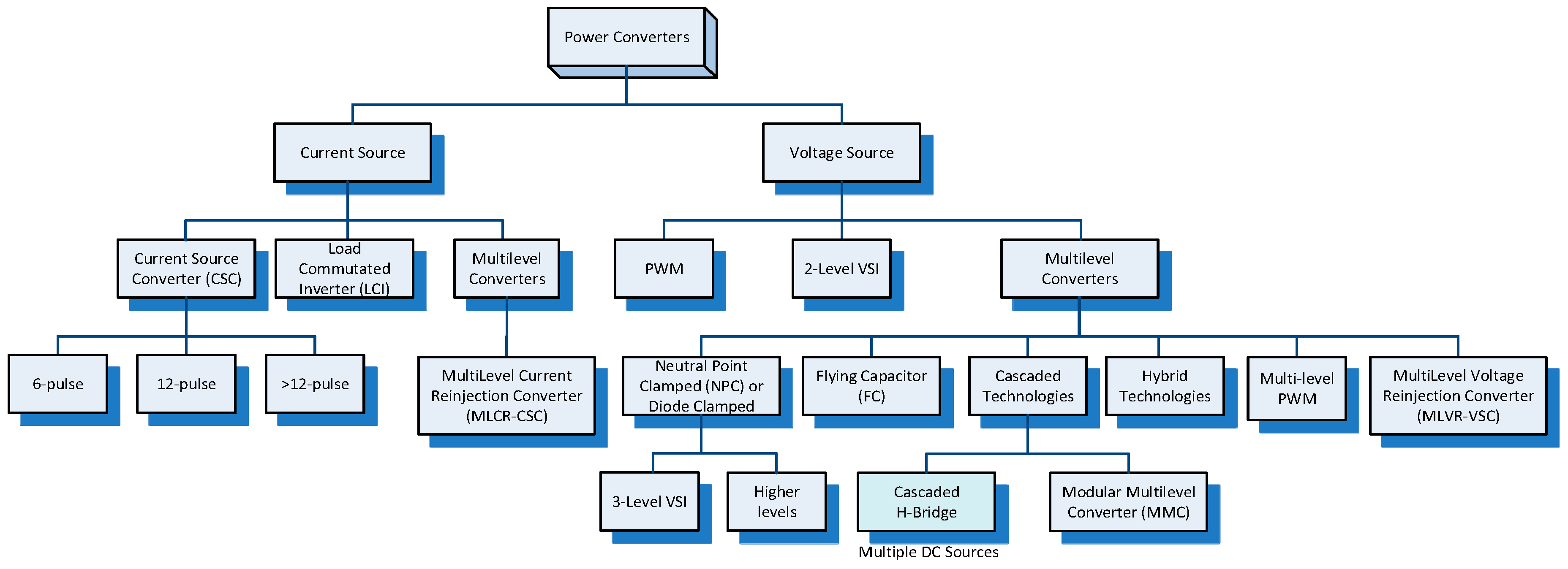
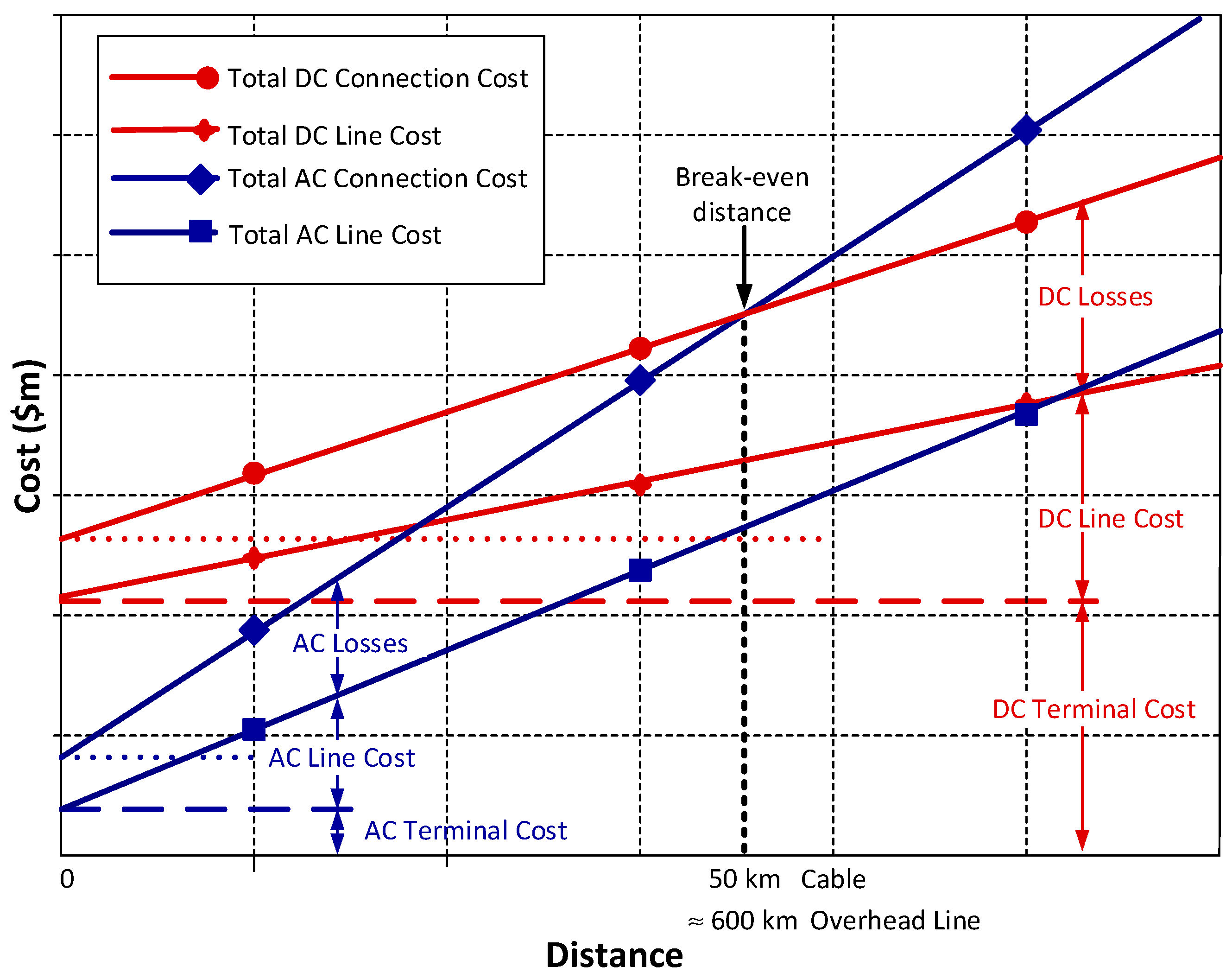

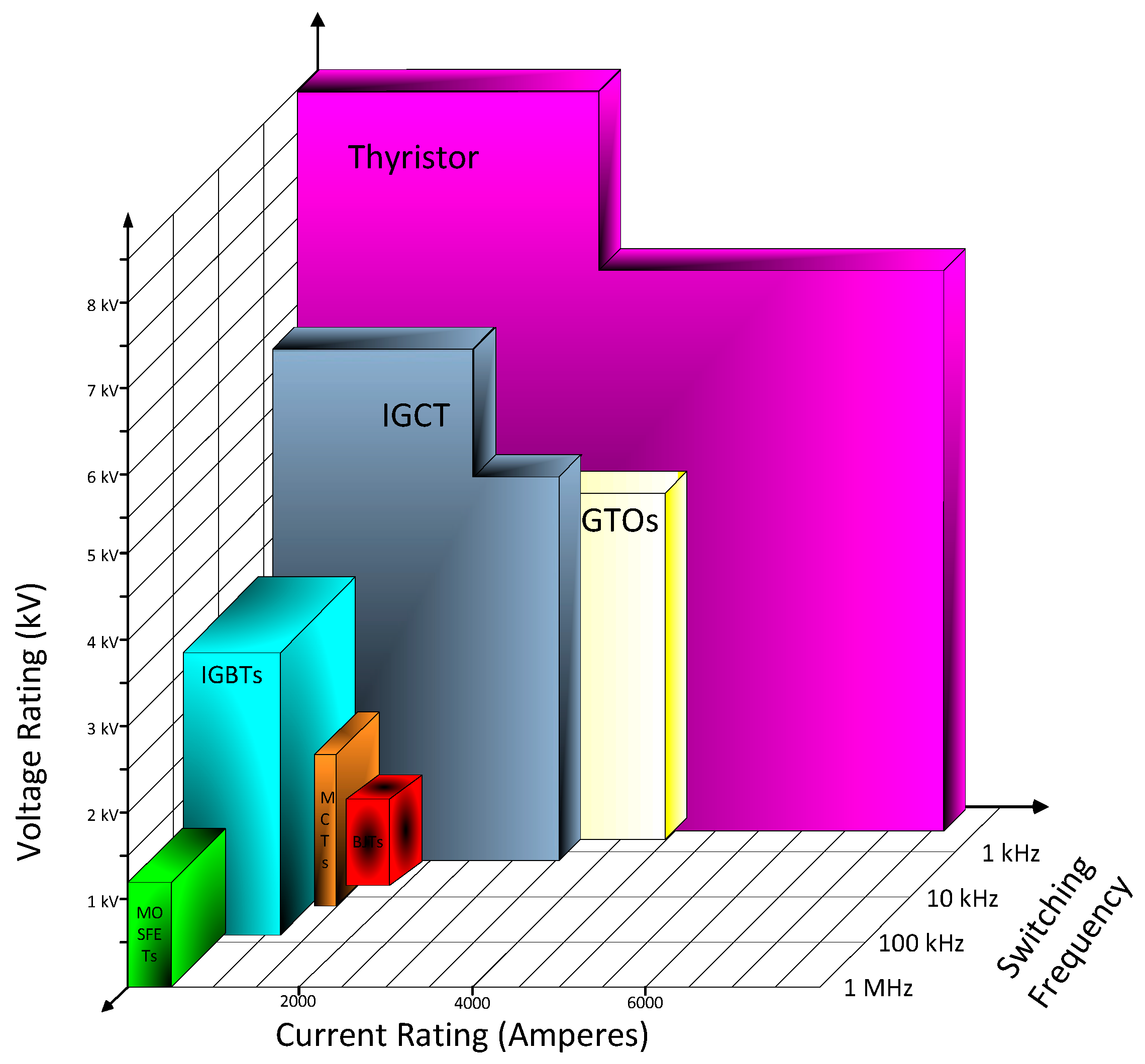

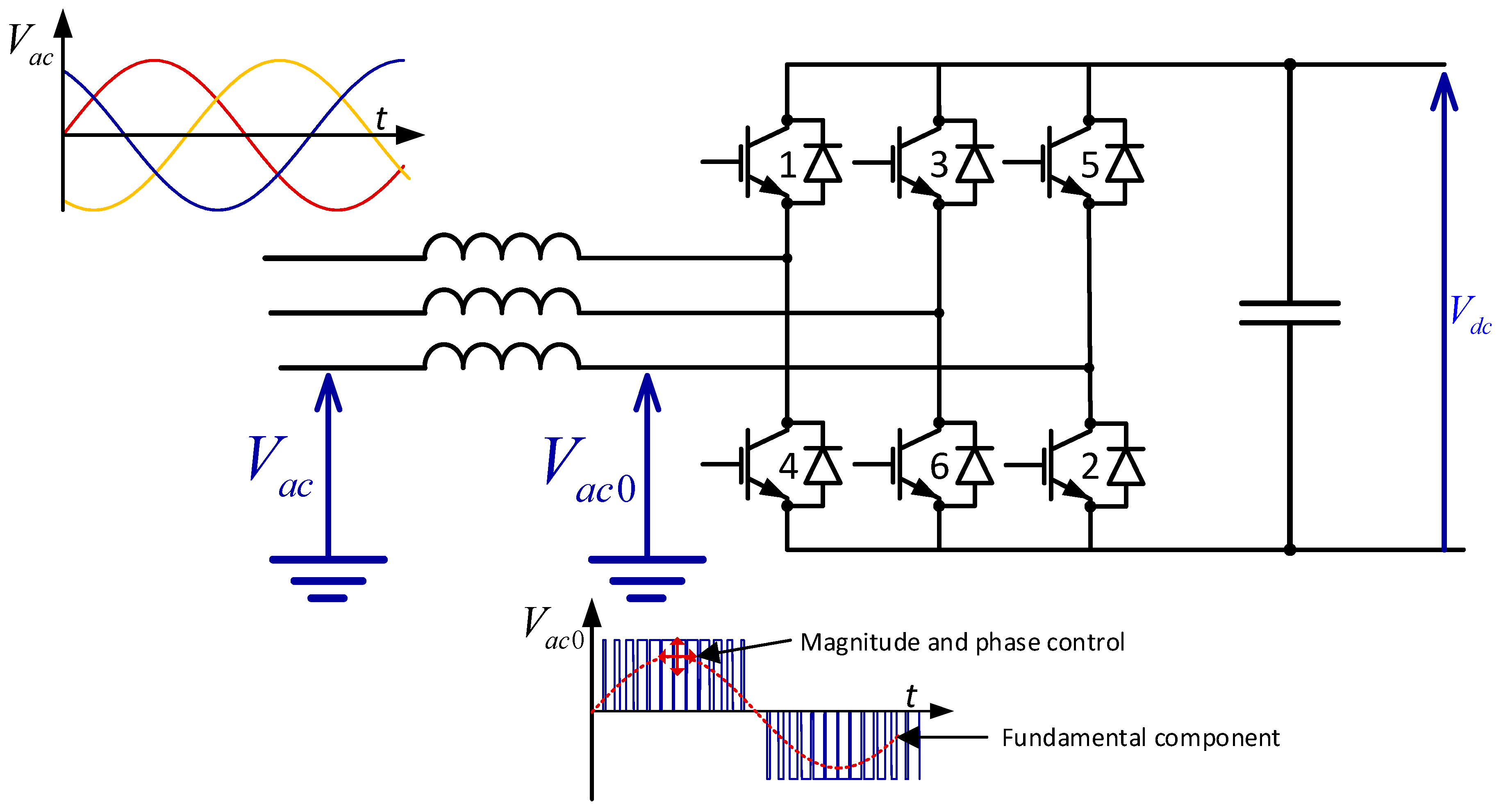
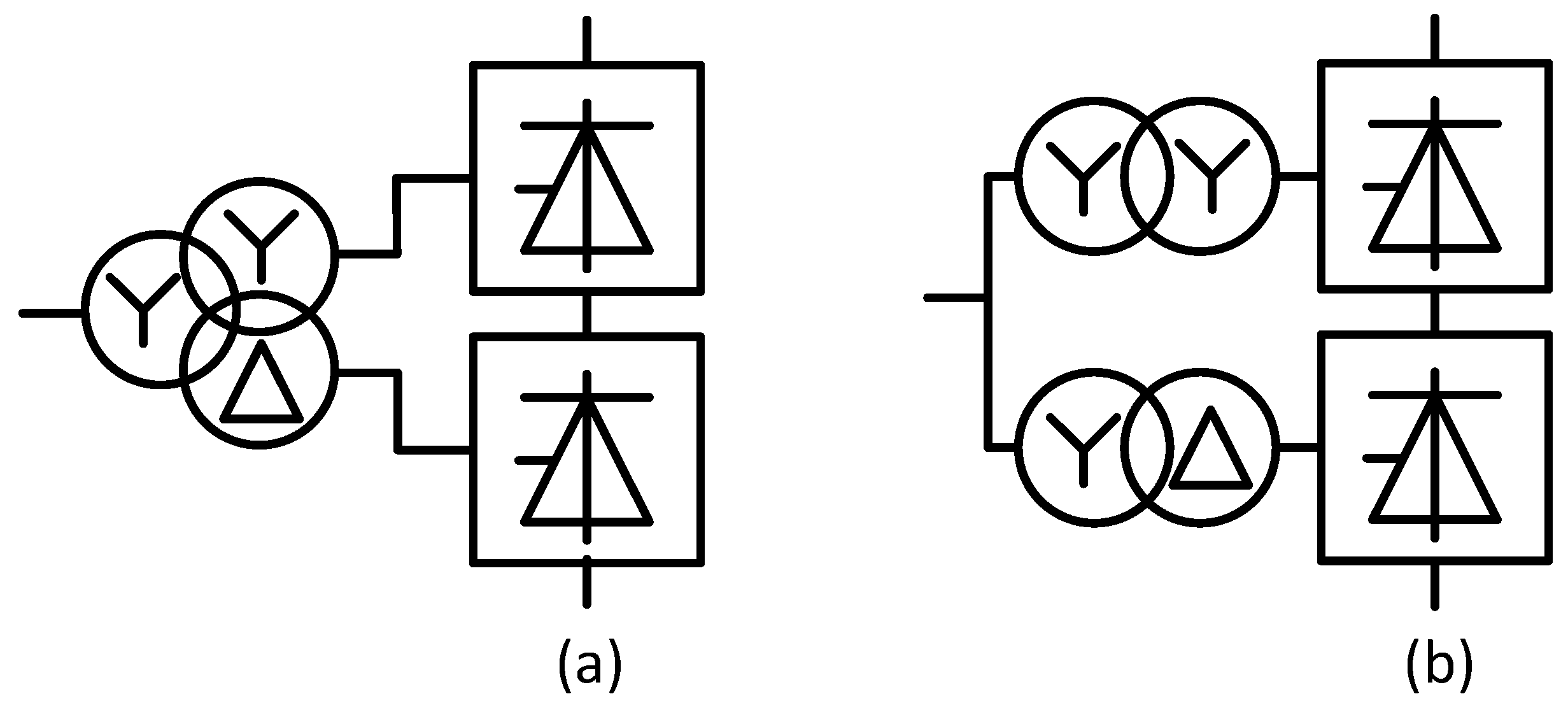
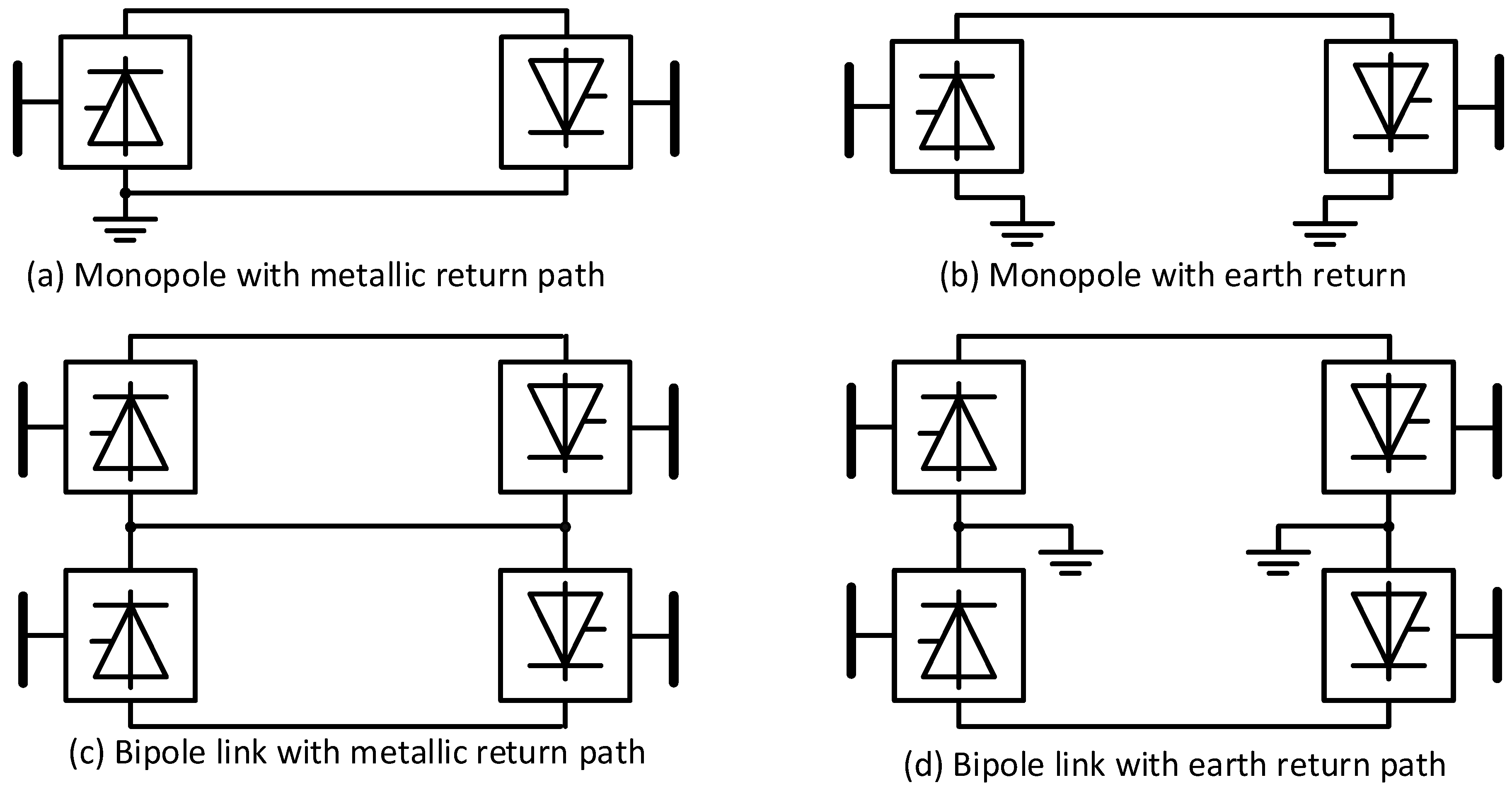



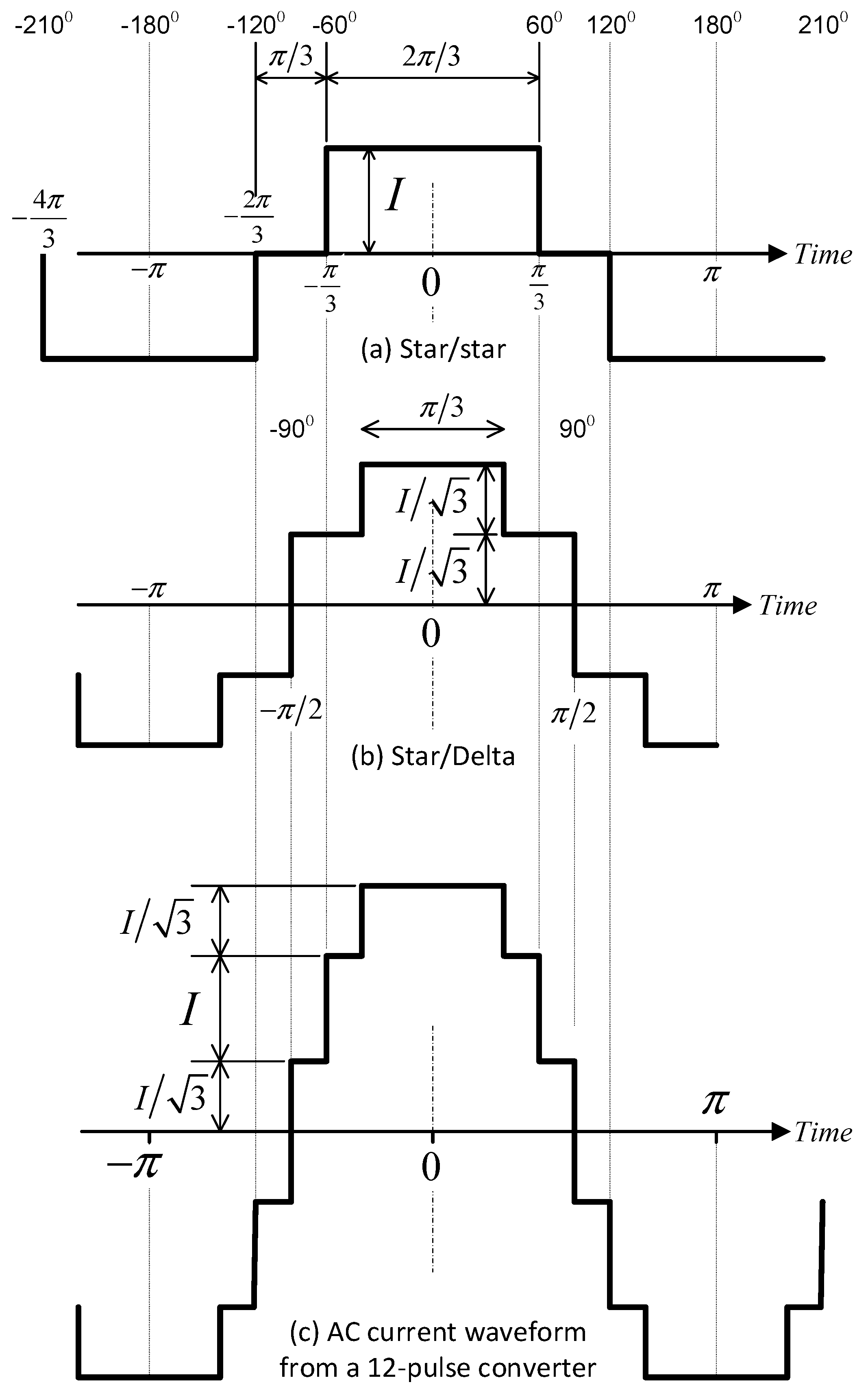

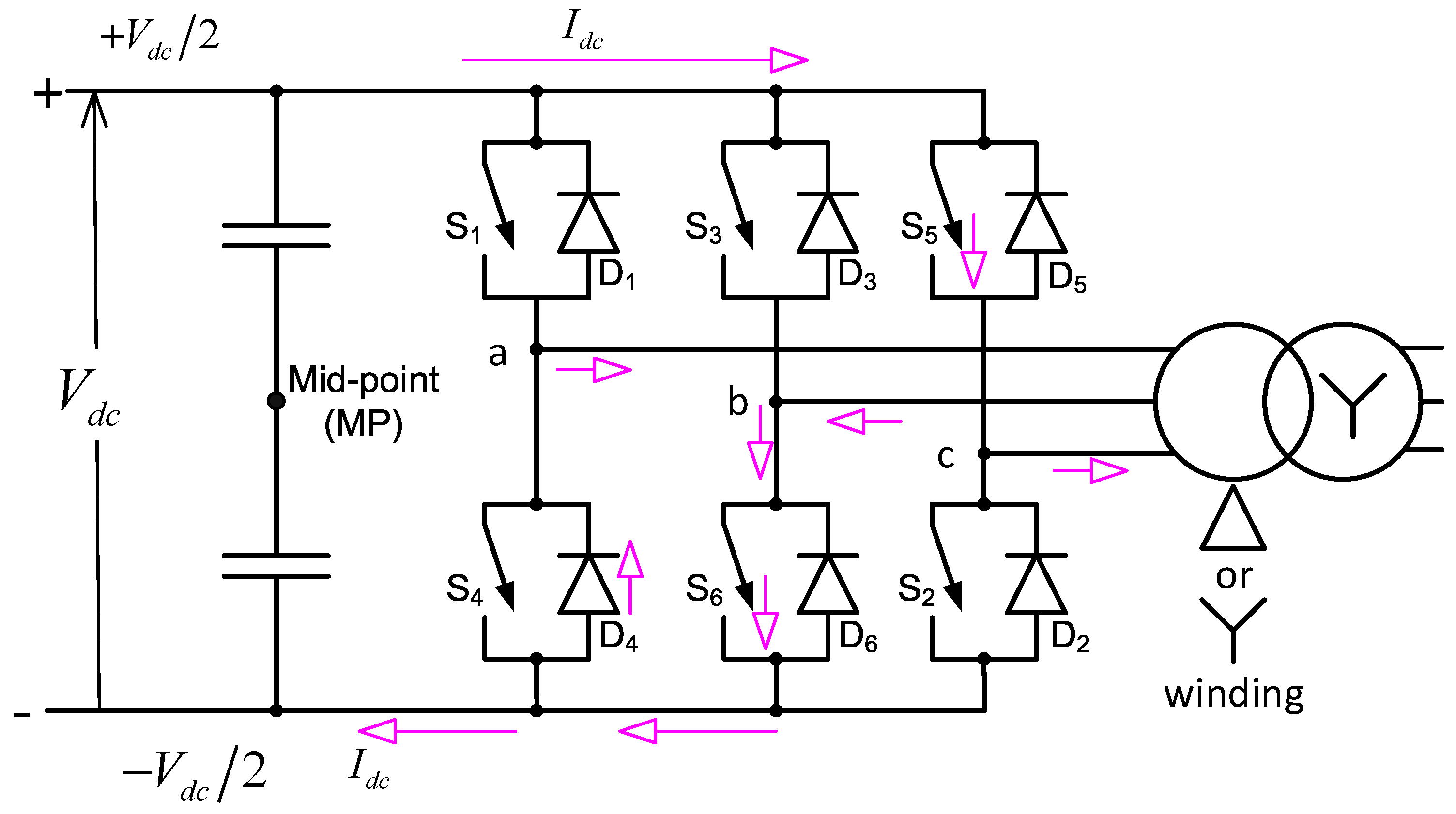
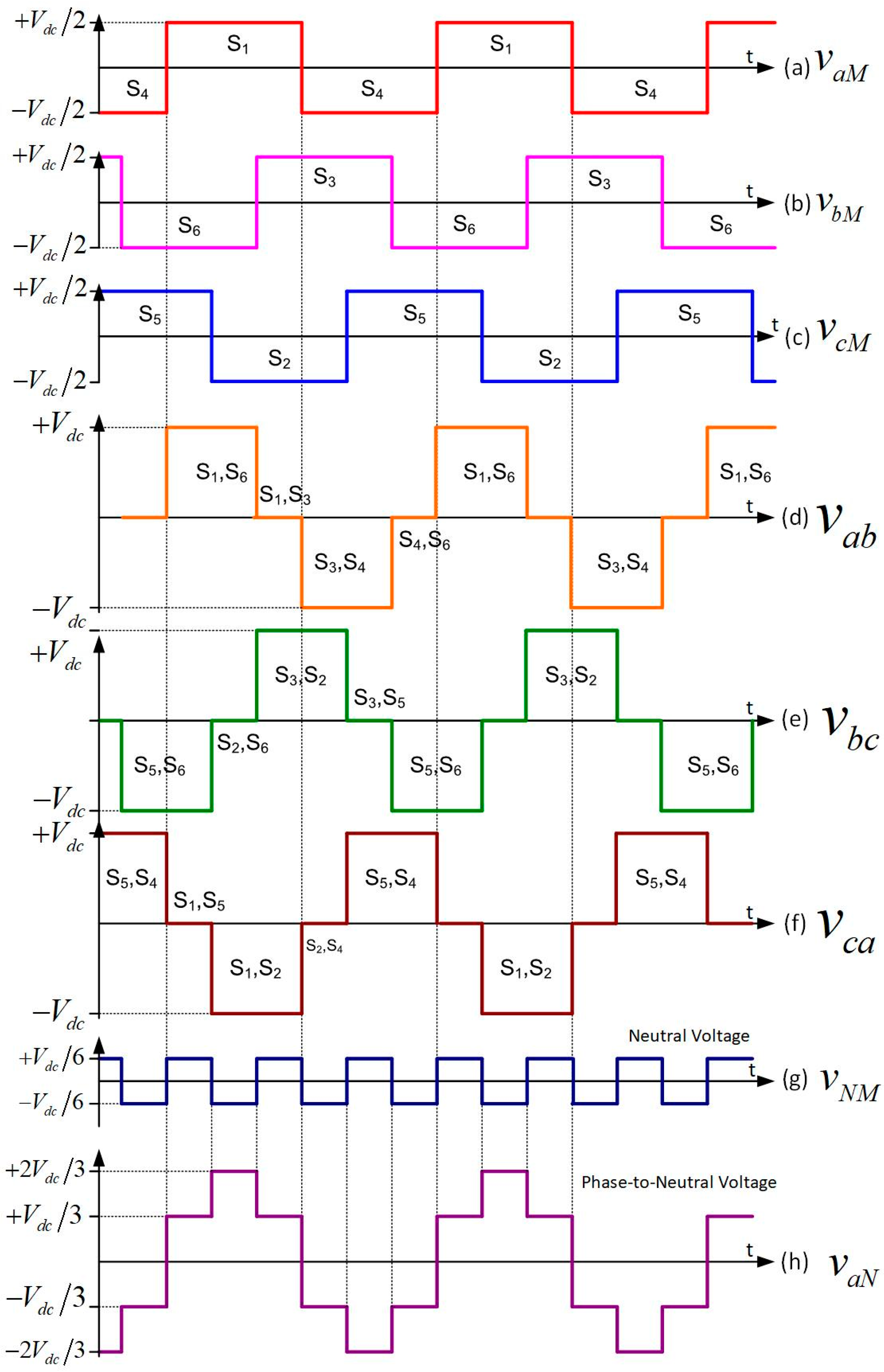
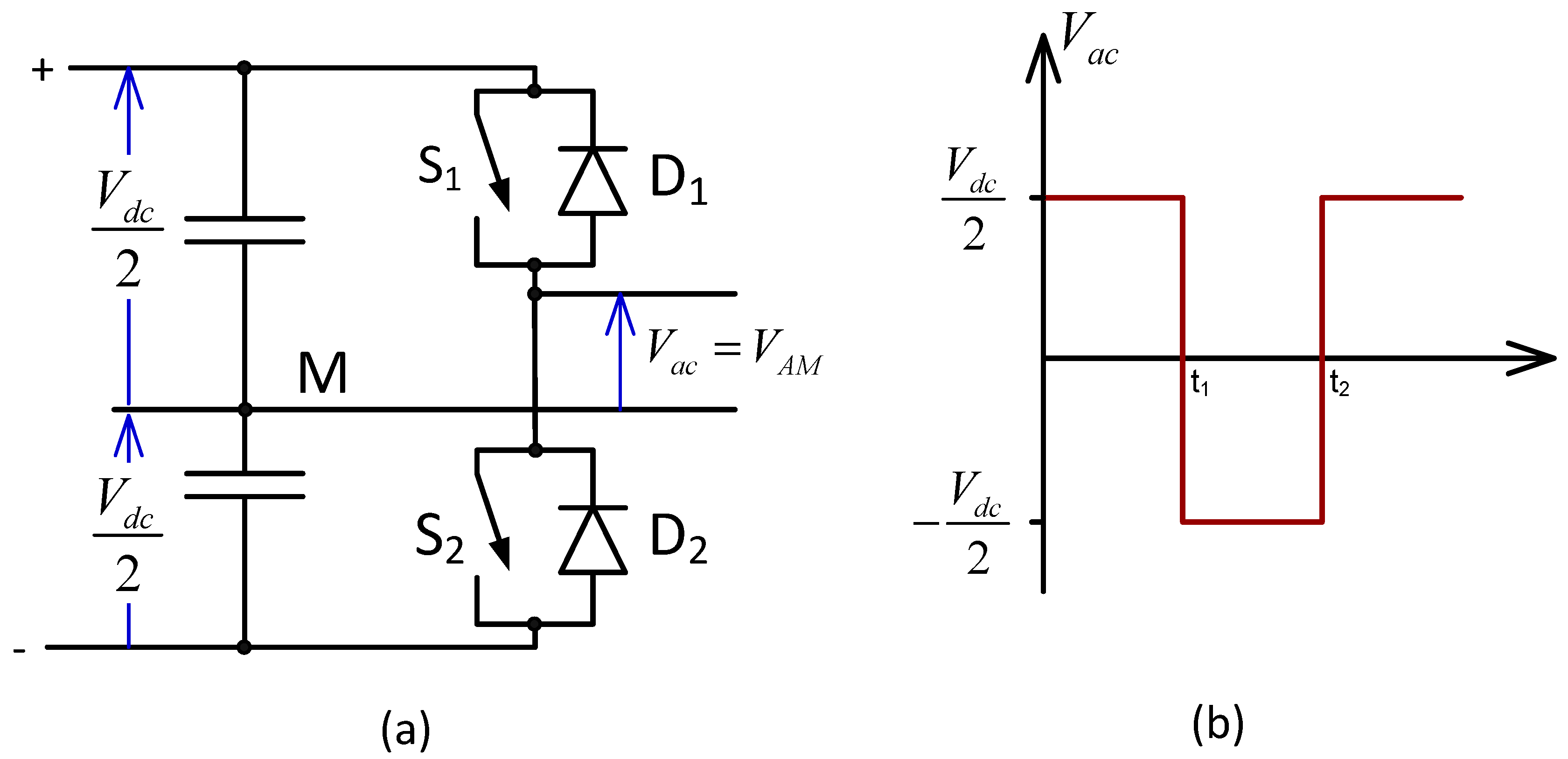
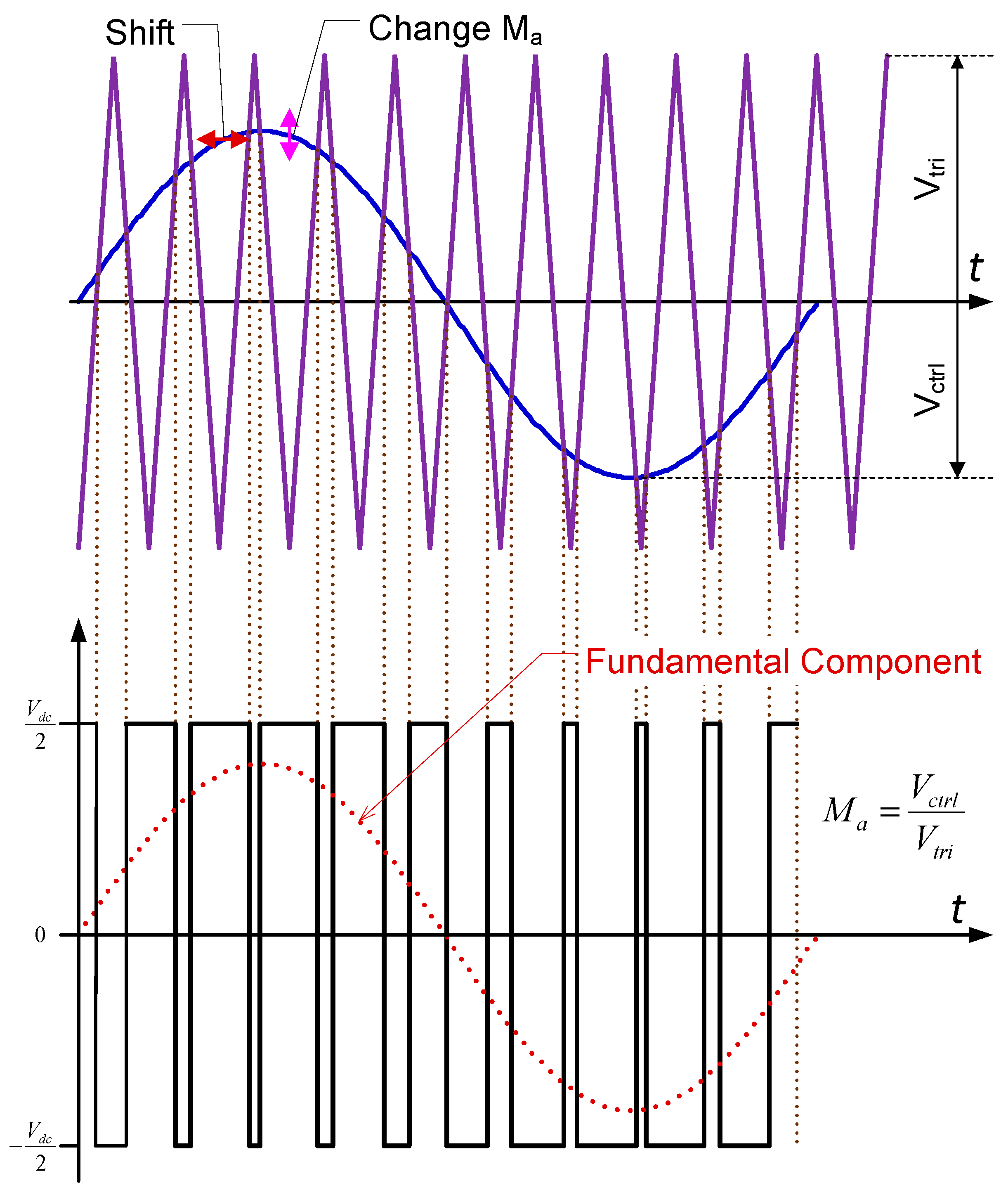
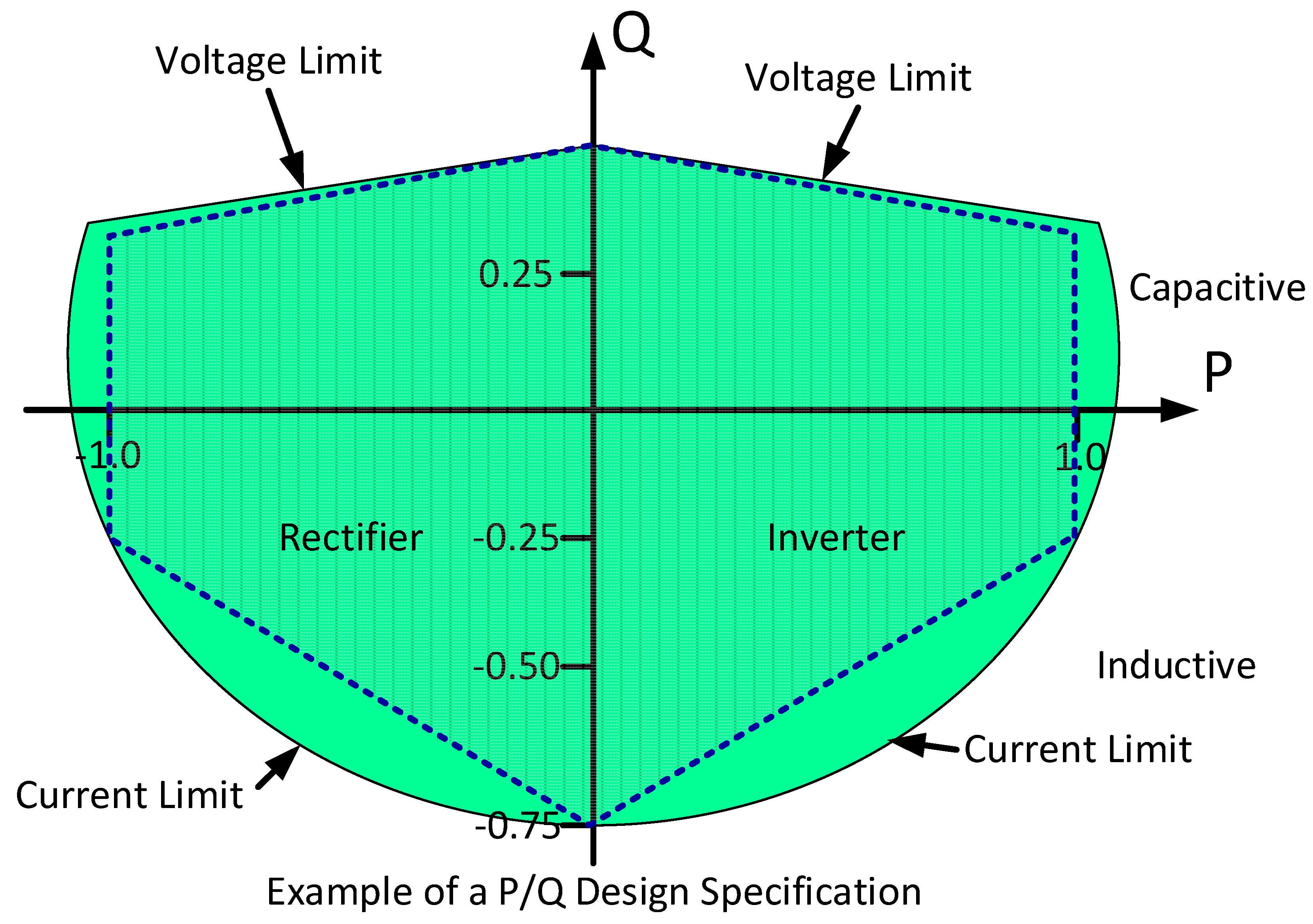
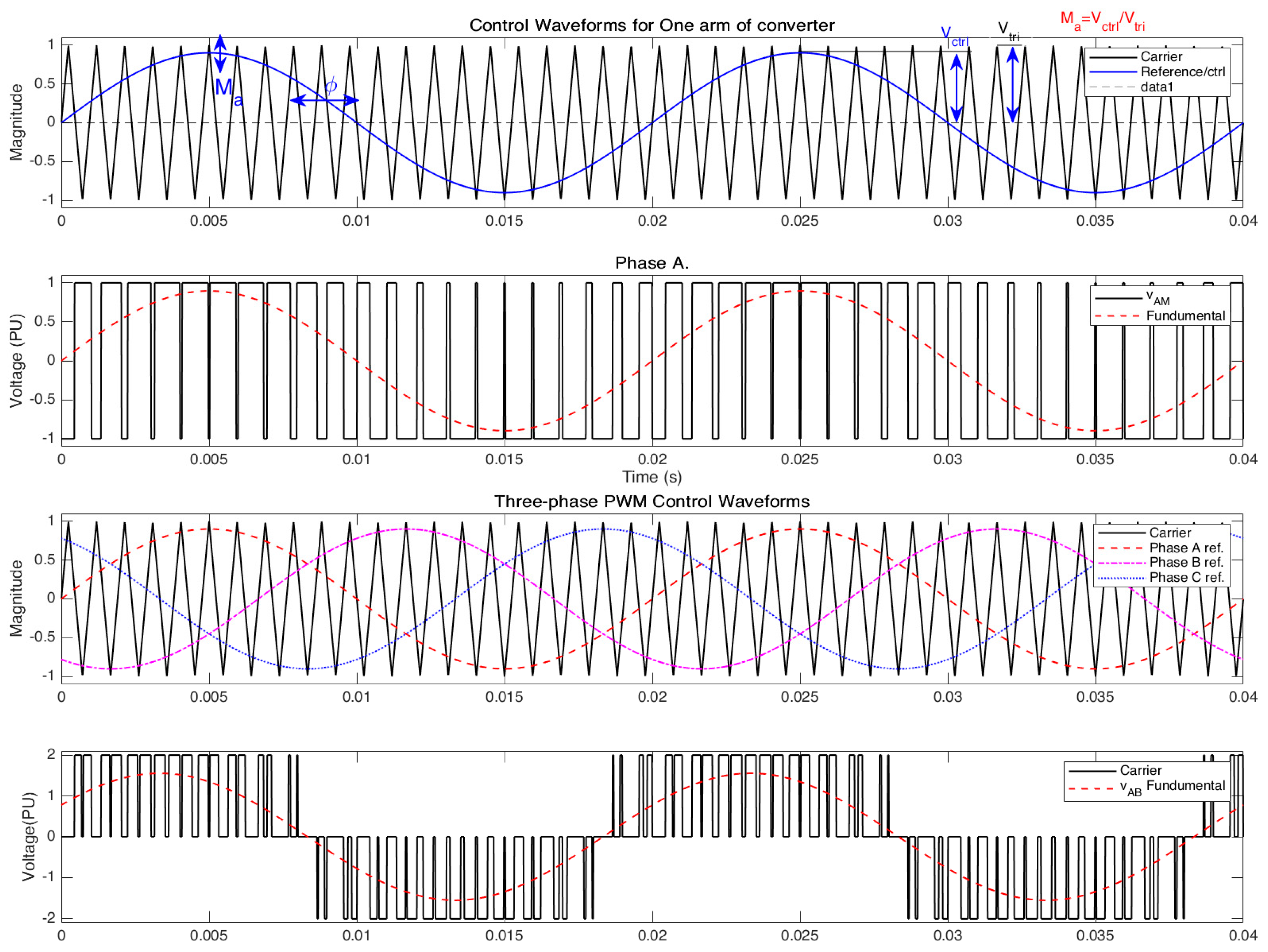
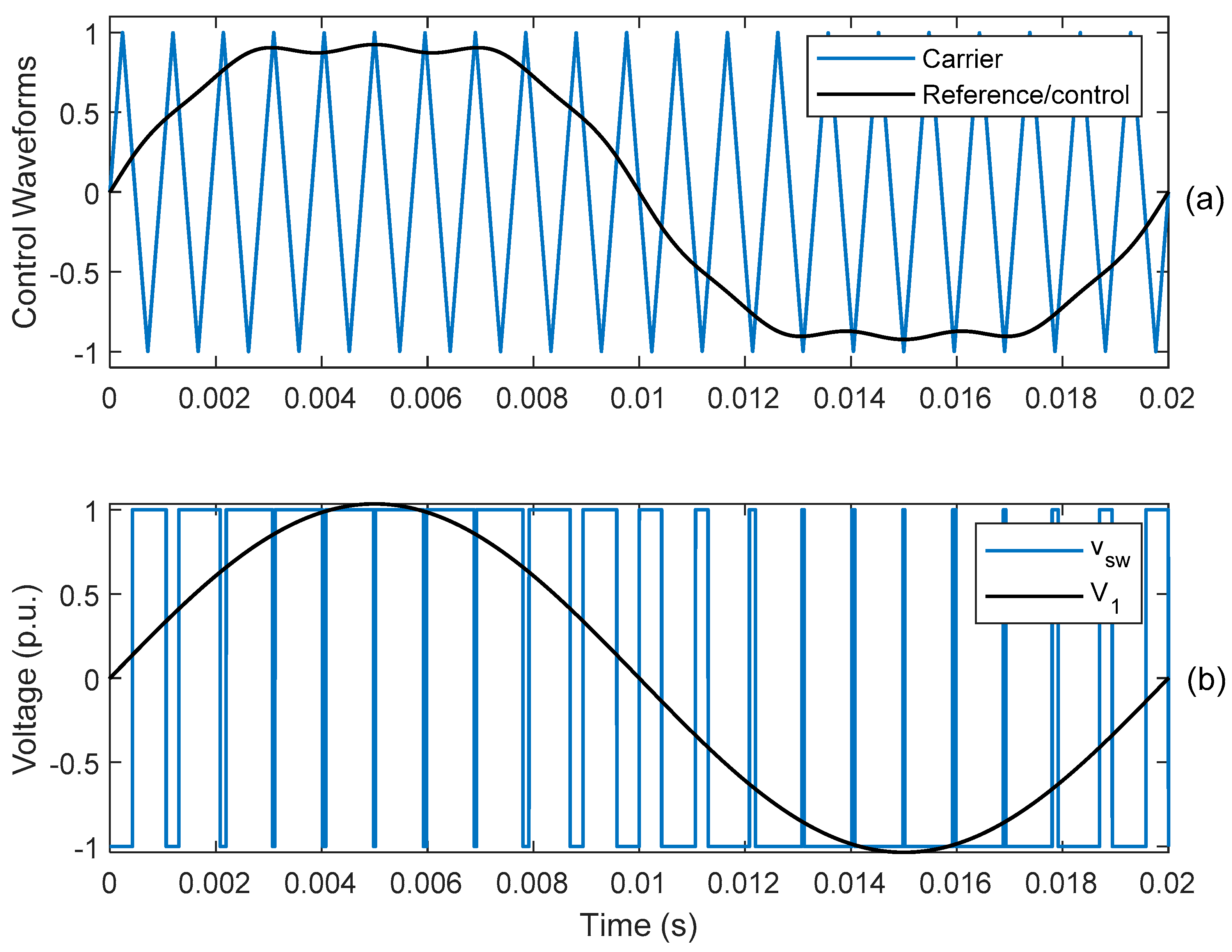
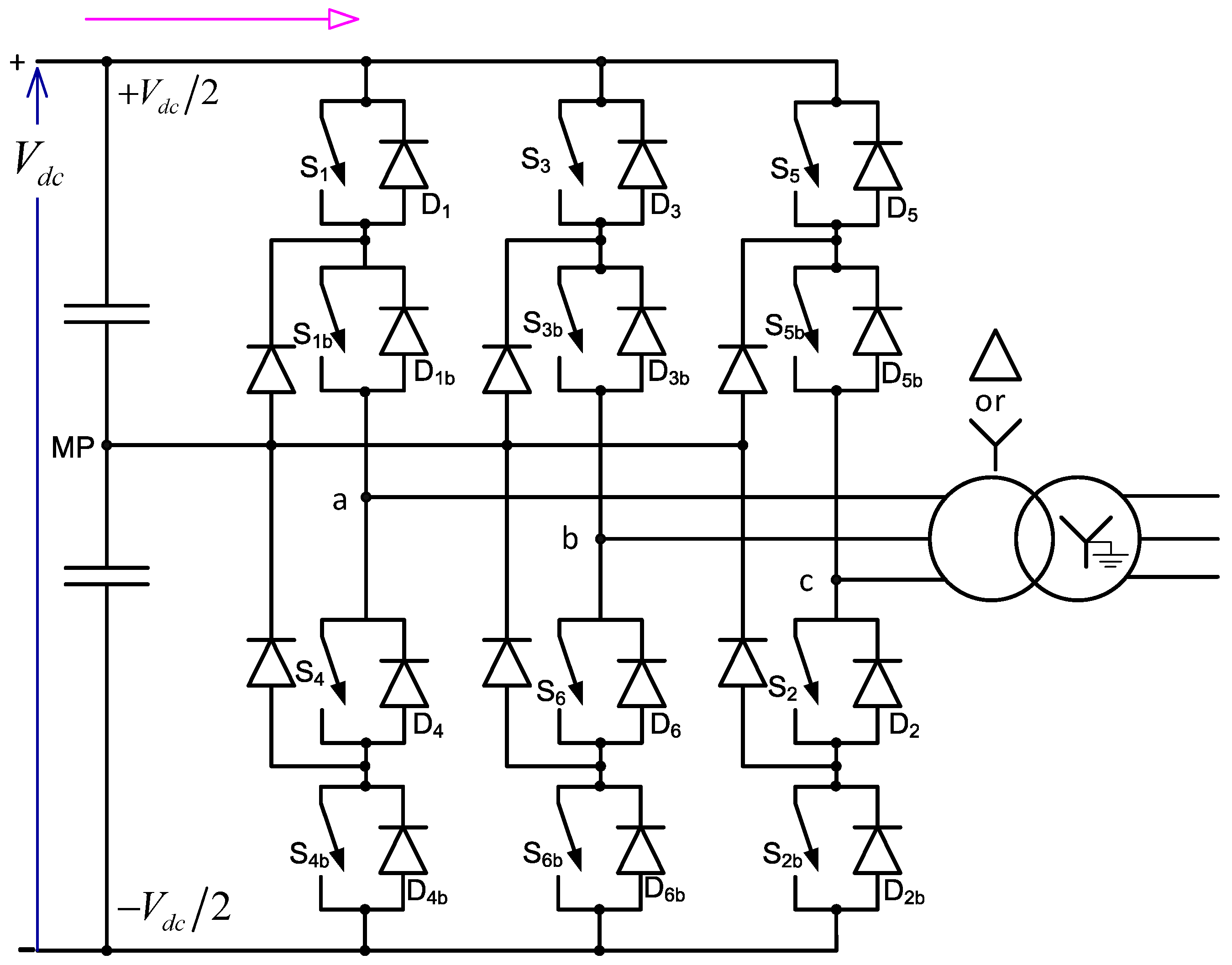

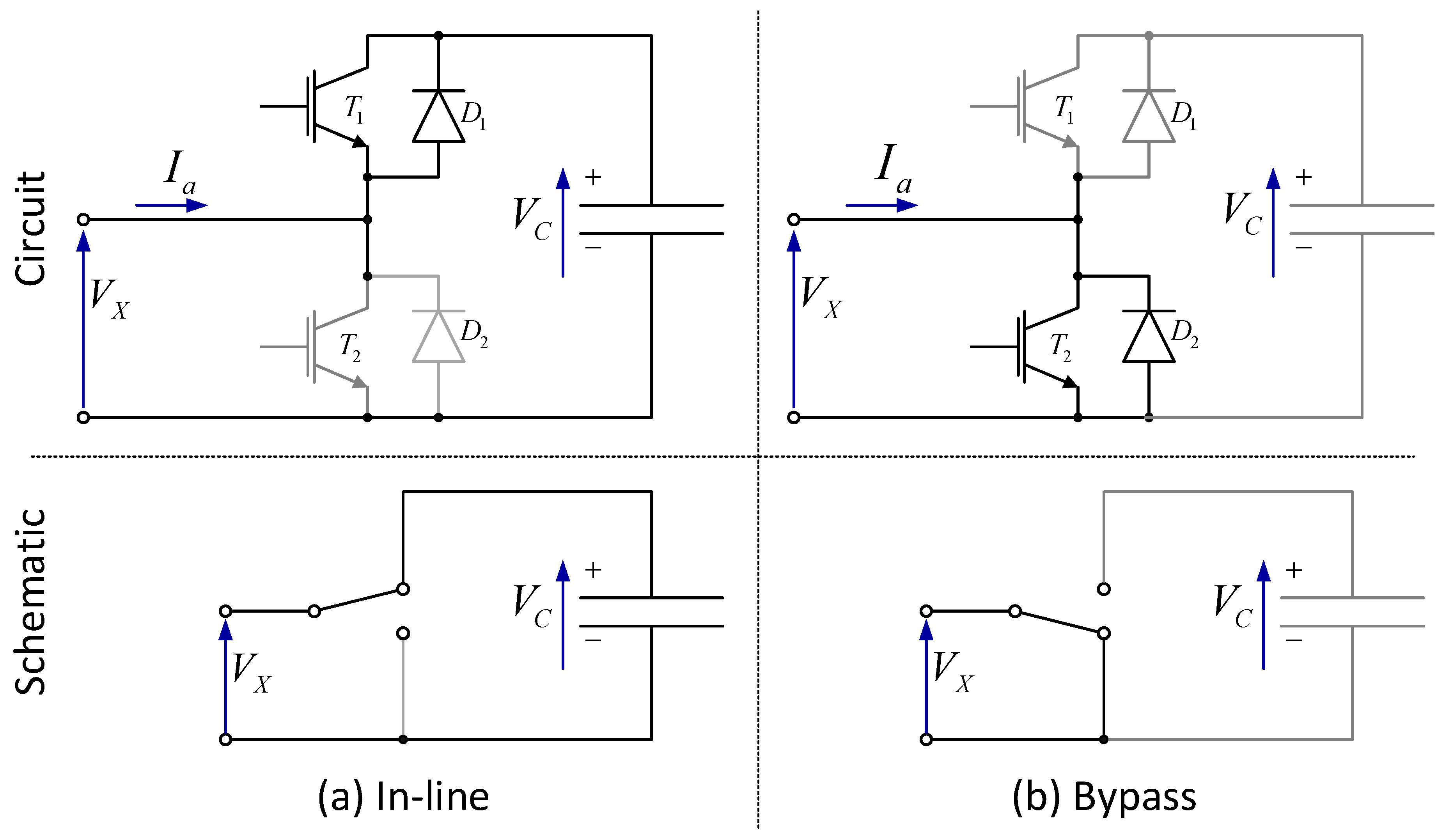
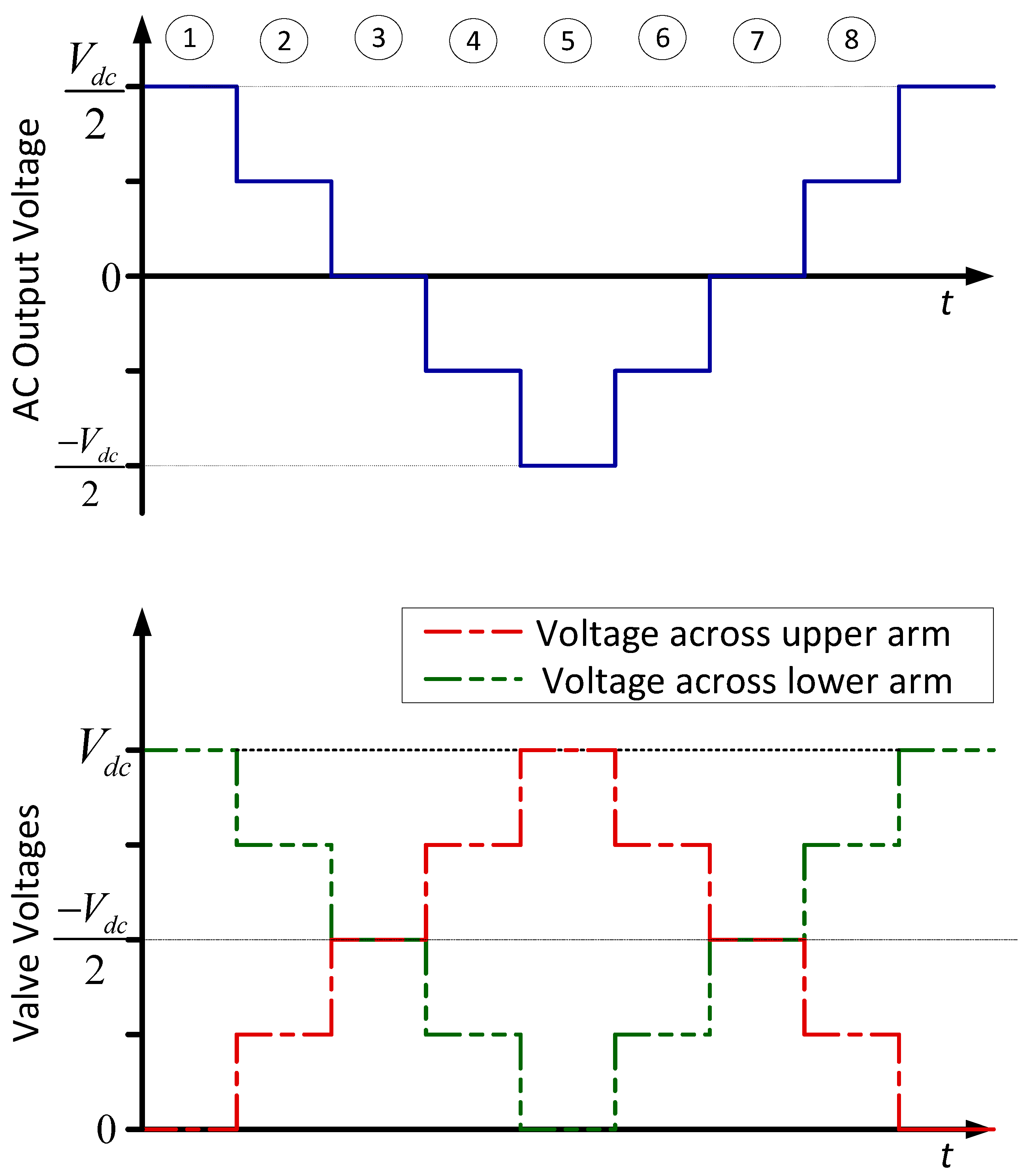
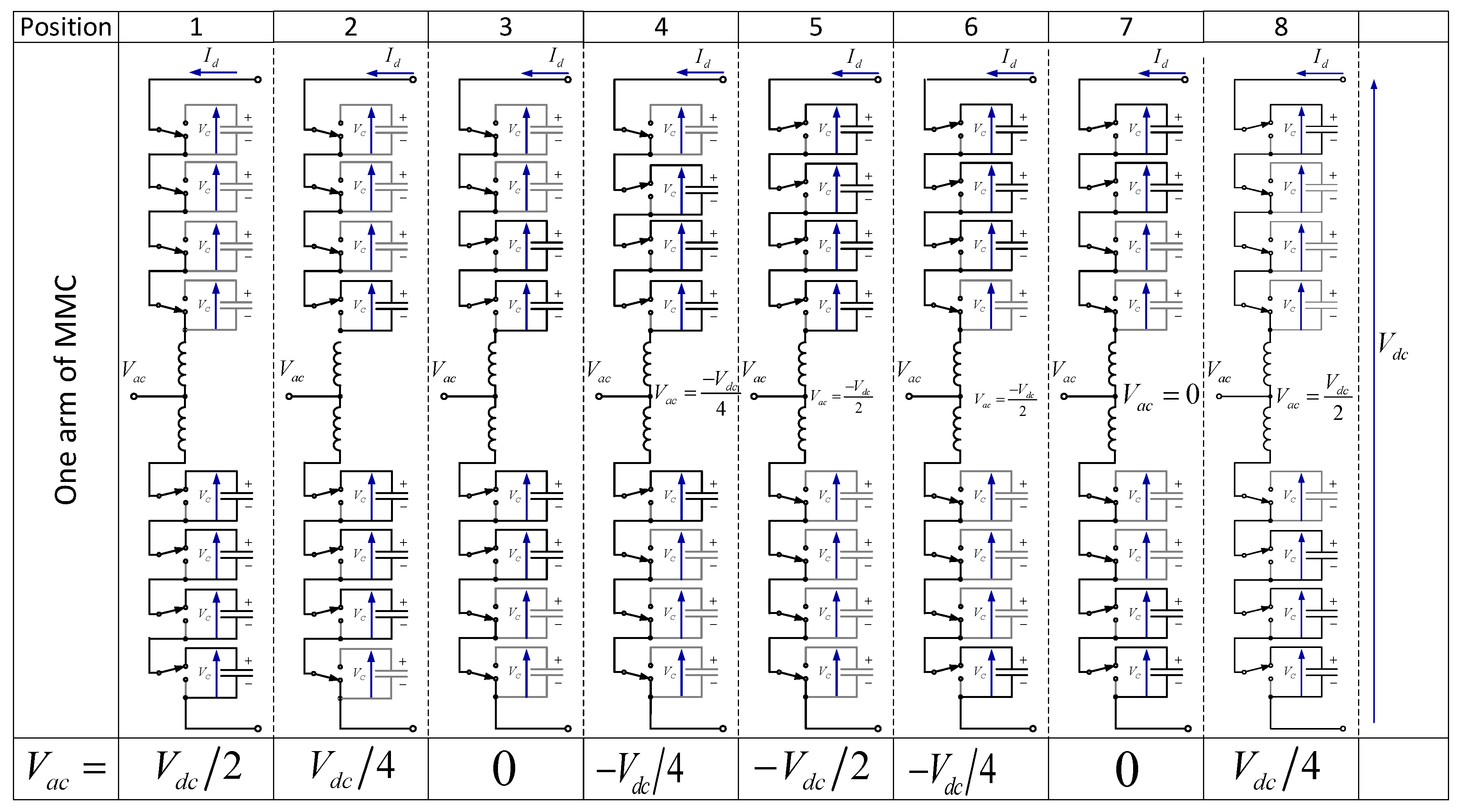


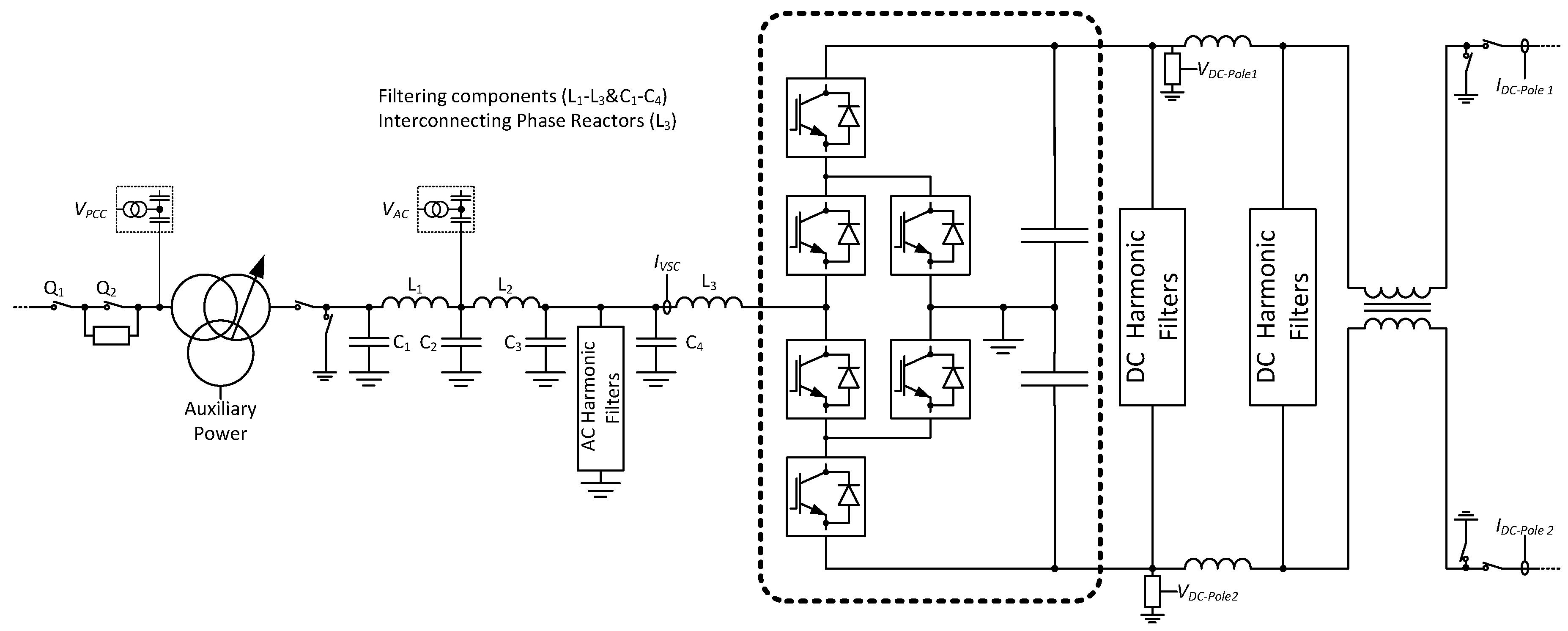


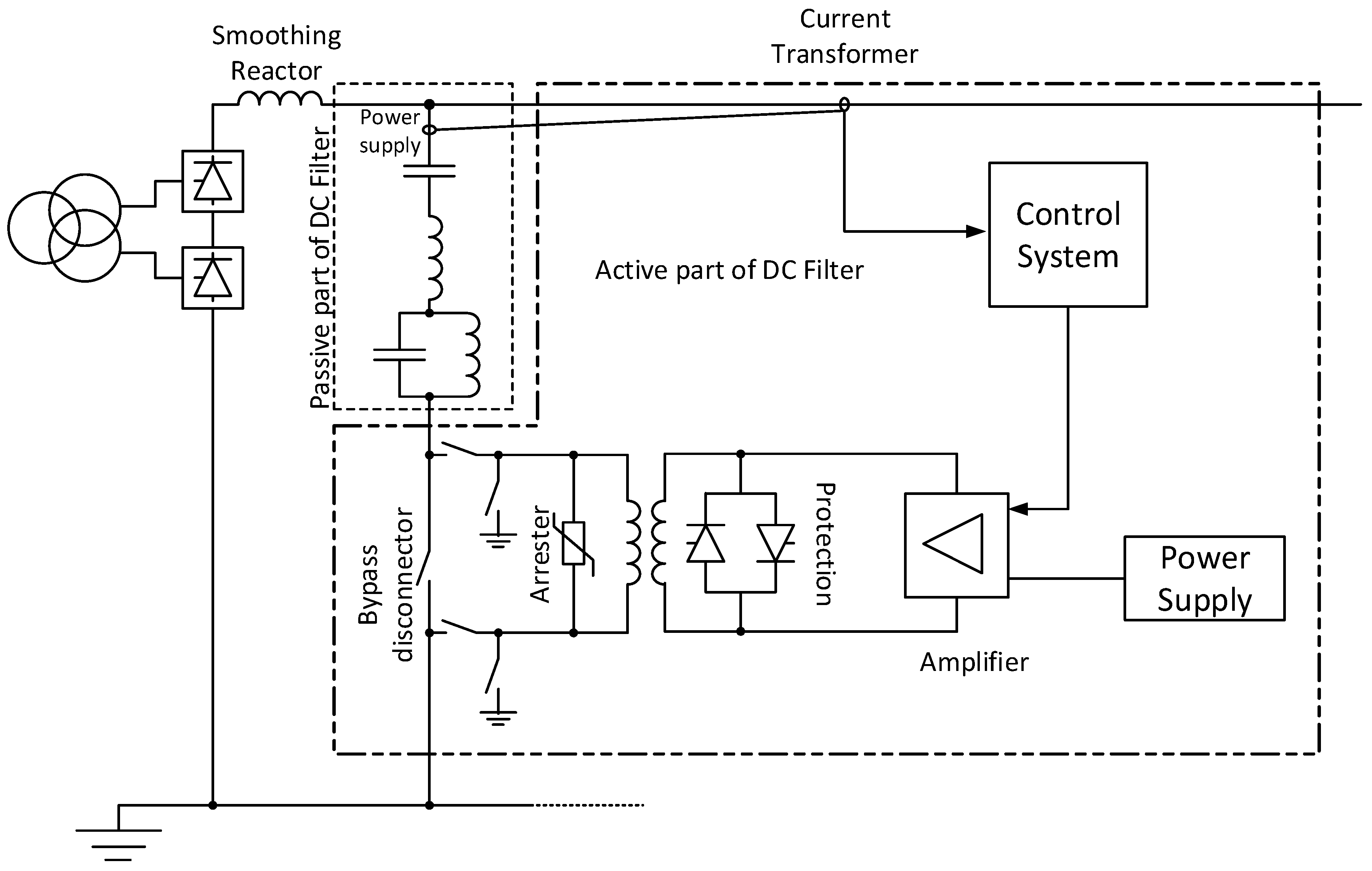
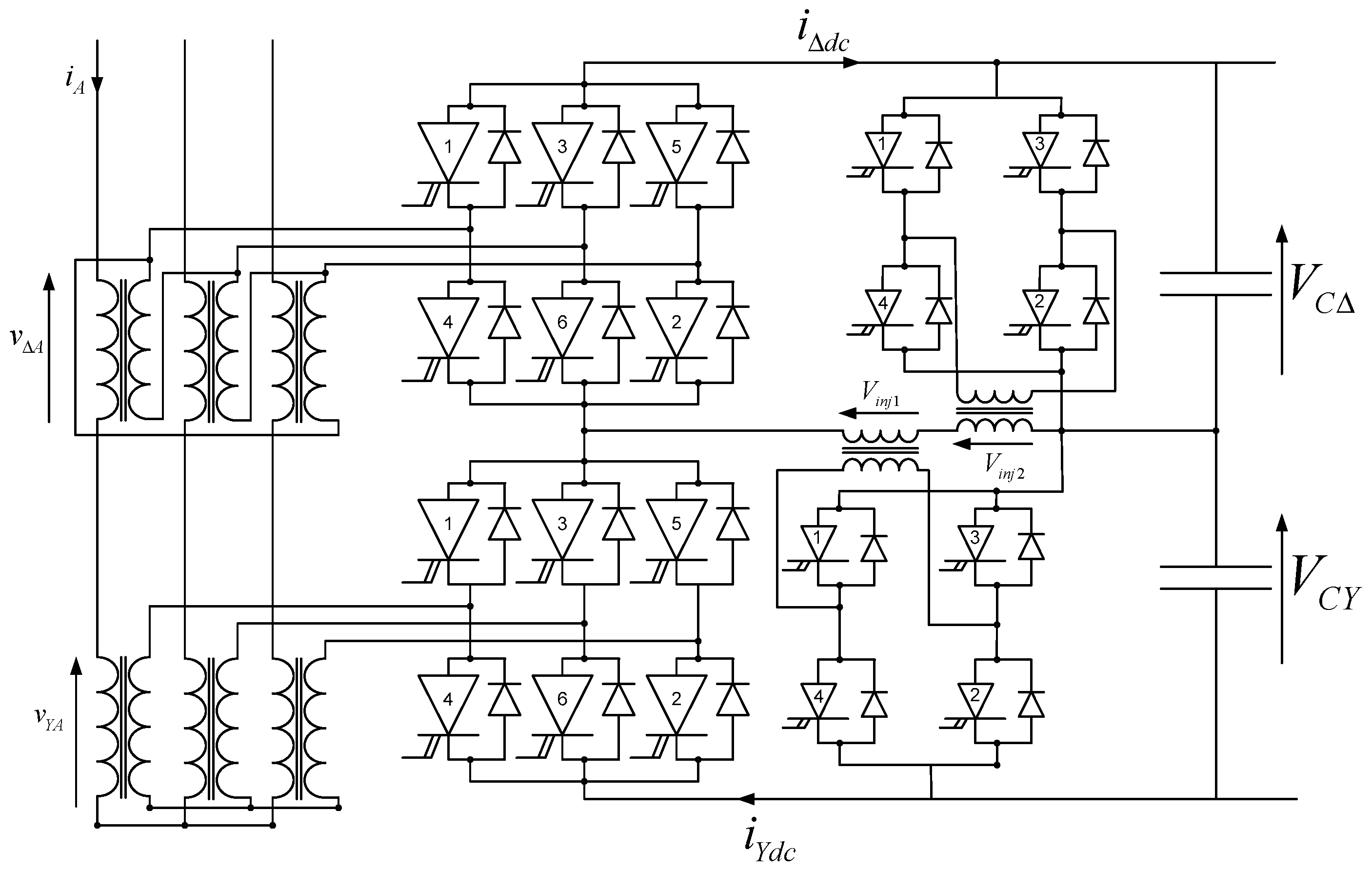
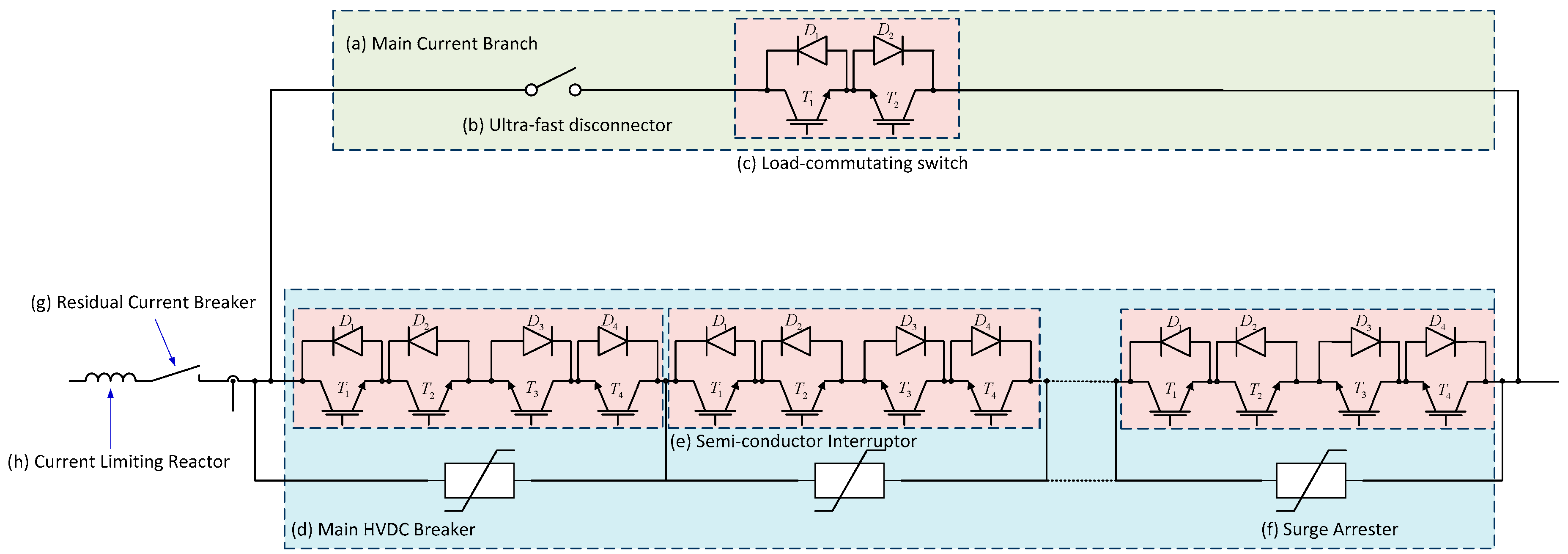
| Characteristic | LCC HVDC | VSC HVDC |
|---|---|---|
| Store energy in | inductance | capacitance |
| Semiconductor | withstands voltage in either polarity | Combination can pass current in either direction |
| Semiconductor switch | turned ON by control action | turned ON & OFF by control action |
| DC Voltage | changes polarity, reserves the power flow direction | Direction does not change |
| DC Current | direction does not change | direction changes to reverse the power flow |
| Turn-OFF | commutation relies on the external circuit | independent of external circuit |
| P & Q | P & Q dependent | independent P & Q control |
| Quadrants | 2 quadrant operation | 4-quadrant operation |
| Real Power capability | Very High | Lower than LCC |
| System Strength | Requires minimum SCR to commutate thyristors | Operates into weaker AC systems (or passive) |
| Overload capability | Good | Weak |
| DC line faults | Copes well. Control action can extinguish arc | More challenging as diodes provide path. |
| Harmonic generation | Significant, AC & DC harmonic filters required | Small, minimal filtering required. |
| Reactive power | Needed | Fine reactive power control in both directions |
| “Black” start | requires additional equipment | capable |
| Name | Year | Technology | Length | DC Voltage | Power Rating |
|---|---|---|---|---|---|
| Cable/OHL | (kV) | P (MW) | |||
| Gotland 1 | 1954 | Mercury-arc | 98/0 | 200 | 20 |
| Cross-Channel | 1961 | Mercury-arc | 64/0 | ±100 | 160 |
| NZ Inter-Island 1 | 1965 | Mercury-arc | 40/571 | ±250 | 600 |
| SACOI 1 | 1965 | Mercury-arc | 365/118 | ±200 | 200 |
| Konti-Skan 1 | 1965 | Mercury-arc | 87/89 | ±250 | 250 |
| Zhoushan | 1987 | Mercury-arc | 54 | −100 | 50 |
| Vancouver Isl. 1 | 1968 | Mercury | 42/33 | 260 | 312 |
| Pacific DC Intertie | 1970 | Thyristor | 0/1362 | ±500 | 3100 |
| Nelson River Bipole 1 2 | 1977 | Mercury-arc | 0/895 | ±450 | 1620 |
| Skagerrak 1 | 1977 | Thyristor | 130/100 | ±250 | 500 |
| Cahora Bassa 3 | 1979 | Thyristor | 0/1420 | ±533 | 1920 |
| Hokkaido—Honshu | 1979 | Thyristor | 44/149 | ±250 | 300 |
| Zhou Shan 4 | 1982 | Thyristor | 44/149 | +100 | 50 |
| Itaipu 1 | 1984 | Thyristor | 0/785 | ±600 | 3150 |
| Nelson River Bipole 2 | 1985 | Thyristor | 0/940 | ±500 | 1800 |
| Itaipu 2 | 1987 | Thyristor | 0/805 | ±600 | 3150 |
| Fenno-Skan | 1989 | Thyristor | 200/33 | ±400 | 500 |
| Rihand-Delhi | 1990 | Thyristor | 0/814 | ±500 | 1500 |
| Quebec—New England | 1991 | Thyristor | 5/1100 | ±450 | 2250 |
| NZ Inter-Island 2 | 1992 | Merc. & Thyr | 40/571 | +270/−350 | 1240 |
| Baltic Cable | 1994 | Thyristor | 250/12 | 450 | 600 |
| Garabi HVDC | 2002 | Merc. | 0/0 | ±70 | 2200 |
| Three Gorges—Changzhou | 2003 | Thyristor | 0/890 | ±500 | 3000 |
| Three Gorges—Guangdong 1 | 2004 | Thyristor | 0/980 | ±500 | 3000 |
| Three Gorges—Guangdong | 2004 | Thyristor | 0/940 | ±500 | 3000 |
| BassLink | 2006 | Thyristor | 298/72 | ±400 | 500 |
| NorNed | 2008 | Thyristor | 580/0 | ±450 | 700 |
| Yunnan–Guangdong | 2010 | Thyristor | 0/1418 | ±800 | 5000 |
| XIangjiaba-Shanghai | 2010 | Thyristor | 0/1907 | ±800 | 6400 |
| NZ Inter-Island 3 | 2013 | Thyristor | 40/571 | ±350 | 1200 |
| Estlink 2 | 2014 | Thyristor | 157/14 | ±450 | 650 |
| North-East Agra | 2017 | Thyristor | 0/1728 | ±800 | 6000 |
| Nelson River Bipole 3 | 2018 | Thyristor | 0/1324 | ±500 | 2000 |
| Name | Year | Topology | Length (km) | Switching Frequency | DC Voltage | Power Rating | |
|---|---|---|---|---|---|---|---|
| Cable 1/OHL | (Hz) | (kV) | P (MW) | Q(MVAr) | |||
| Gotland VSC | 1999 | 2-level | 70/0 | 1950 | ±80 | 50 | −55 to 50 |
| Tjäreborg | 2000 | 2-level | 4.3/0 | 1950 | ±9 | 7.2 | −3 to 4 |
| Directlink | 2000 | 2-level | 59/0 | 1950 | ±80 | 180 | −165 to 90 |
| Eagle Pass | 2000 | 3-level 2 | 0/0 | 1500 | ±15.9 | 36 | ±36 |
| MurrayLink | 2002 | 3-level 3 | 176/0 | 1350 | ±150 | 220 | −150 to 140 |
| CrossSound | 2002 | 3-level 3 | 40/0 | 1260 | ±150 | 330 | ±150 |
| Troll A | 2005 | 2-level | 70/0 | 2000 | ±60 | 84 | −20 to 24 |
| Estlink1 | 2006 | 2-level 4 | 105/0 | 1150 | ±150 | 350 | ±125 |
| BorWin1 | 2009 | 2-level | 200/0 | ±150 | 400 | ||
| Trans Bay Cable | 2010 | MMC | 85/0 | <150 | ±200 | 400 | ±170 |
| Nanao Island 5 | 2013 | MMC 6 | 10/32 | ±160 | 200/100/500 | ||
| Zhoushan Isl. 7 | 2014 | MMC | 134/0 | ±200 | 400 | ||
| INELFE | 2015 | MMC | 64.5/0 | ±320 | 2 × 1000 | ||
| BorWin2 | 2015 | MMC | 200/0 | ±300 | 800 | ||
| HelWin1, | 2015 | MMC | 130/0 | ±250 | 576 | ||
| HelWin2 | 2015 | MMC | 130/0 | ±320 | 690 | ||
| Dolwin1 | 2015 | Casc. 2-L 8 | 165/0 | ±320 | 800 | ||
| Dolwin2 | 2015 | MMC | 135/0 | ±320 | 900 | ||
| Dolwin3 | 2018 | MMC | 162/0 | ±320 | 900 | ||
| SylWin1 | 2015 | MMC | 205/0 | ±300 | 864 | ||
| BorWin3 | 2019 | MMC | 160/0 | ±320 | 900 | ||
| Zhangbei HVDC 9 | 2019 10 | MMC | 170/648 11 | ±500 | 1500/4500 |
© 2020 by the authors. Licensee MDPI, Basel, Switzerland. This article is an open access article distributed under the terms and conditions of the Creative Commons Attribution (CC BY) license (http://creativecommons.org/licenses/by/4.0/).
Share and Cite
Watson, N.R.; Watson, J.D. An Overview of HVDC Technology. Energies 2020, 13, 4342. https://doi.org/10.3390/en13174342
Watson NR, Watson JD. An Overview of HVDC Technology. Energies. 2020; 13(17):4342. https://doi.org/10.3390/en13174342
Chicago/Turabian StyleWatson, Neville R., and Jeremy D. Watson. 2020. "An Overview of HVDC Technology" Energies 13, no. 17: 4342. https://doi.org/10.3390/en13174342
APA StyleWatson, N. R., & Watson, J. D. (2020). An Overview of HVDC Technology. Energies, 13(17), 4342. https://doi.org/10.3390/en13174342







